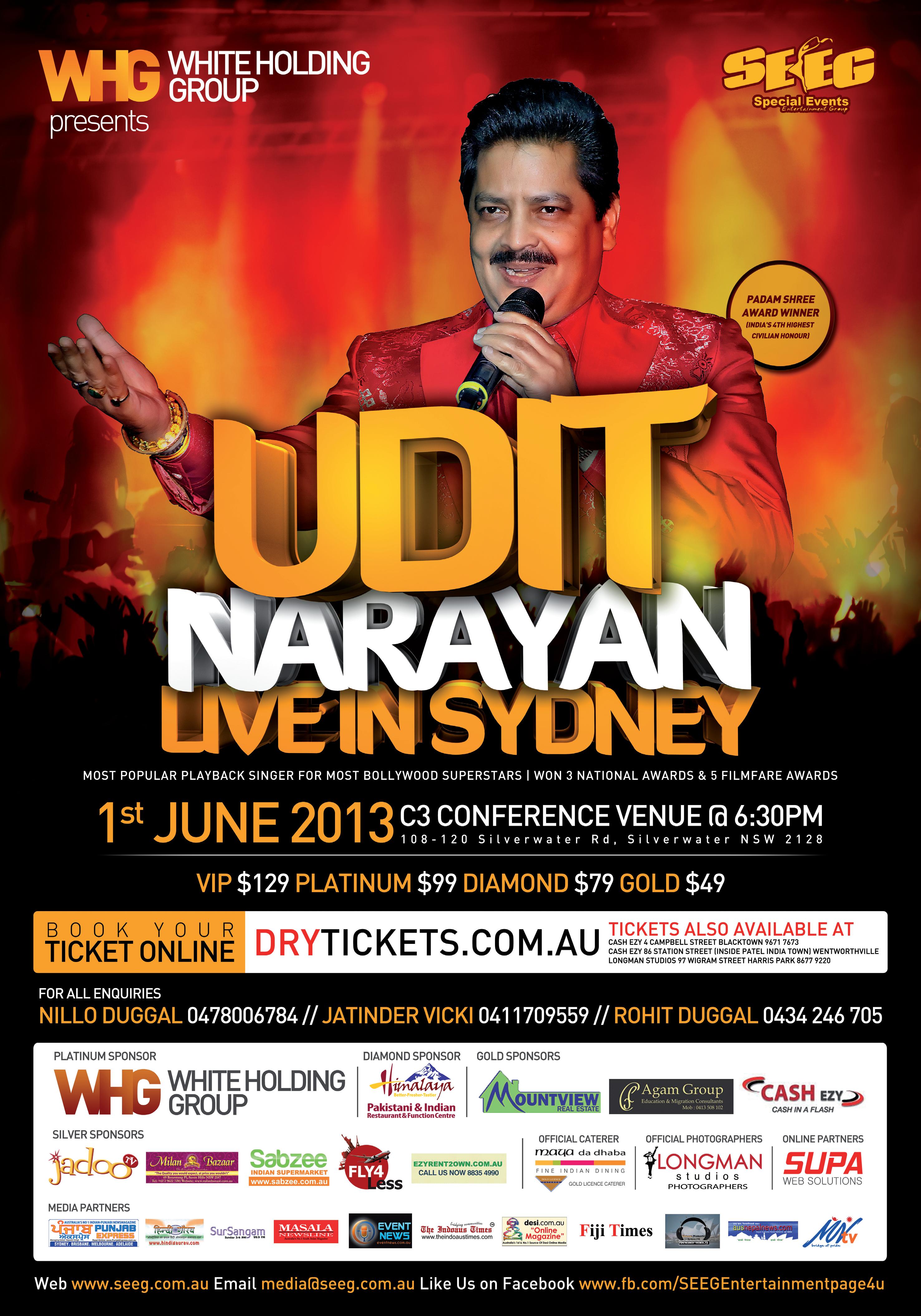






PUBLISHER
Pawan Luthra
EDITOR
Rajni Anand Luthra
ASSISTANT EDITOR
Lena Peacock
Sheryl Dixit

MELBOURNE
Preeti Jabbal
CONTRIBUTORS
Hasnain Zaheer, Christopher Cyrill,
Hor,








Pawan Luthra
EDITOR
Rajni Anand Luthra
ASSISTANT EDITOR
Lena Peacock
Sheryl Dixit

MELBOURNE
Preeti Jabbal
CONTRIBUTORS
Hasnain Zaheer, Christopher Cyrill,
Hor,
jobs and setting up homes.
PAWAN LUTHRA
They call it the ‘empty nest’ syndrome: the loss of a sense of purpose that develops in parents when the children leave home. As young adults move out to go to university or to a new job in another city, or because they are married, their middle-aged parents need to make adjustments in their own lives. The sudden feeling of bareness inside a home thus far filled with the exuberance of youth, can take some getting used to. Sometimes the loss of the close relationship with children can also lead to depression, particularly in mothers who have been the primary care giver in the family. This can be starker for stay-at-home mothers as compared to mothers who work fulltime or part-time.
For migrant Indian-Australian parents, especially mums who follow traditional maternal roles, this change in the family situation can stir up issues of identity. After migrating to a new country, often armed with tertiary degrees from back home, they set about building a new life, settling into
However, once the children arrive, there may be a collective family decision for the woman to stop working and become a full-time mother. Motherly responsibilities morph from preparing school lunches, drop-offs and pickups, canteen duties and homework supervision (and doing the odd school project themselves), to sleepovers, organising play dates, Saturday sport and selective school/HSC coaching, besides of course, running a full house. The professional world seems miles away. As the children grow into teenagers, their dependency on the parents gradually lessens until they are ready to leave home.
While it is manageable when the first-born leaves home for studies, or travel, or work, or marriage, the empty nest syndrome hits hard when the youngest goes out into the world.
After the initial feeling of freedom, there can be a sense of hollowness as the mother tries to find new meaning in life. By this time, the professional skill set and qualifications are out of date, and they could be at a time in their life when the desire to re-skill may be low. This issue of empty nesting could be at a difficult time when their own elderly parents are experiencing health and frailty issues. This emotional vacuum from a
generation above and the one below can be somewhat daunting. There could be perceived (or real) lack of support from the husband, whose energies are fully employed on the office front.
While there is no easy way to combat this situation, the women need to take this opportunity to find a new passion in their life. Efforts need to be made to rekindle the relationship with one’s partner. If there were activities like travel which were put aside for “when we are free of the kids,” these can be now be indulged in. When the motivation strikes, new skills could be acquired at TAFE or community college courses. These might well be hobby courses, such as art appreciation or photography. Exercise to get in shape and stay healthy could be another activity. Finding other empty nesters and organising travel and other adventure options can also be undertaken.
But perhaps one of the solutions is to be a bit more selfish while the children are growing up: start a hobby which can be carried on with more vigour when the children have left home. Planning ahead for this next stage of life, thereby ensuring that you’re looking forward to it, can make all the difference.
Pawan Luthra is the current Parliament of NSW Multicultural Journalist of the Year.

Sandip
Nima Menon, Chitra Sudarshan, Usha Ramanujam
SPIRITUAL
Gopa Kuteeram
4th Sun of every month
4pm-5:30pm
The Global Organisation for Divinity runs free spiritual educational classes for children aged 4-12 years. Crestwood Community Centre, Crestwood Drive, Baulkham Hills. Parents can join in the devotional lecture by Sri Deepak Vinod. Classes are also being run in Liverpool.
Baulkham Hills details: Jayashree on 02 9620 4676. Liverpool details: Deepak Vinod 0422 127 956.

Chinmaya Mission activities
Classes
Shishu Vihar
Classes for children between the age of 2- 4.5 years, tailored to increase love and bonding between parent and child. Vedanta Classes In Castle Hill & Epping on Wednesday nights.
Meditation Classes
10-week program at Castle Hill Sanskrit Classes
10-week program for beginners (Course 1) and advanced students (Course 2) at Castle Hill. Hindi Classes
Beginners level starting in May at Crestwood Community Centre, Baulkham Hills.
Details: Br Gopal Chaitanya 0416 482 149.
Ramakrishna Sarada Vedanta Society of NSW activities
Buddha’s Birthday celebration
Sunday 26 May 10:30am12:30pm
Hari Om Ramakrishna
Chant, Silent Meditation, Talk & Guided Meditation by Graeme Lyall A.M (Past Chairman of Buddhist Council of NSW) and Talk by Pravrajika Gayatriprana. Offering and distribution of
Sweets and Savouries. Both at: Vedanta Hall, 15 Liverpool Road, Croydon. Details: 02 9745 4320 or www.saradavedanta.org
Shri Shiva Mandir presents Shanidev Jayanti
Sat 8 June 11am-6:30pm Shani Jayanti falls on Amavasya in Vaishakh month and Shani Jayanti is celebrated as the birthday of Lord Shanidev. Prayers are considered important to one’s prospective plans to avoid the Shani Dosham.
Abhishegam Archna $25 (11am-5pm).
Shanidev Katha and Mantra Recital (5:30-6:30pm).
Shri Shiva Mandir, 201 Eagleview Road, Minto.
Details: Pt. Chetanbhai Sharma 0415 809 963
Sydney Sakhi Sangam’s Teej function
Sun 14 July 11am-onward This is their 15th year
commemorating Indian women and their friendships.
Details: Nandini 0423 684 340, Sushma 0411 967 374
FILM
The Taj Foundation hosting The Great Gatsby movie night Fri 31 May 6:30pm (screening starts at 7pm)
A night of drama, mingling and fun. Stay on for drinks after the movie.
Tickets: $25
Feel free to dress 1920s style.
Hoyts Cinema Paris, Entertainment Quarter, 38 Driver Avenue, Moore Park
Details: www.tajfoundation.org.au
STAGE
Maya - Youth in Performing Arts
About a Brown - The Musical Fri 12 July 8pm & Sat 13 July 3pm & 7pm This production aims to encompass the day to day
lives and idiosyncrasies of second generation youth with a sub-continental cultural heritage in a stage musical with live orchestra and dance ensembles. All proceeds will be donated to the International Medical Health Organisation. NIDA Theatre, 215 Anzac Parade, Kensington.
Cost: $28-55
Details: www.mayaarts.com.au
MISC
Hindu Council of Australia opportunities available Hindu Council of Australia invites expression of interests from anyone who wishes to expand their horizons and get involved with one of the biggest community events of Sydney. These are voluntary positions.
Details:
Raman Bhalla 0401 057 224 or www.hinducouncil.com.au
Apply: info@deepavali.com.au




If you are unaware of TED, it stands for Technology Entertainment Design and is a series of conferences that were initiated in 1984. Speakers who were often distinctive achievers or overachievers, especially in the worlds of technology, entertainment and design presented their key ideas, discoveries and inventions in 20 minute speeches, which was just enough to succinctly present their ideas in reasonable detail.
TED is held in the West Coast of the United States in Spring and in the UK each Summer, but their hugely popular website TED Talk (www.ted.com) hosts all of these speeches and talks that are relished by millions. Countless TEDx conferences are held throughout the world which are hosted by local enthusiasts under license from TED.
The most popular TEDx in Australia is TEDx Sydney which was held on May 4 at the Sydney Opera House in the presence of more than 2,000 people on-site, and thousands more who joined the video feed remotely, via the internet and through studios. Of

course, thousands more will view these talks on the internet in years to come.
Indian Link attended TEDx and it certainly was an eventful day. “The hunger for ideas, conversation and challenging questions is so breathtaking and gratifying,” said Remo Giuffre, founder of TEDx Sydneym, who opened the conference. “This is the City of Ideas. No other TEDx community in the world has this engagement”
The very first speaker, Prof Ron McCallum, brought the house down with a standing ovation when he described the advancement of technology for the blind, and planted the seed for a renewed appreciation for Braille. He played a piece of audio to the audience and then replayed it at the speed at which he read it in Braille.
Prof McCallum has worked a lifetime to bring Braille texts to Latin America and other poor parts of the world.
Alice Gorman, a space archaeologist, talked about space research, orbital debris and Australia’s contribution to space research. Jennifer Robinson talked about Benny Wenda, a West Papuan activist in asylum that she has represented.
This was followed by a curious piece of music mixed in Maths –The Fibonacci sequence, played out percussion style by musical mathematician
Greg Sheehan. Anyone who likes data would like Simon Jackman. He is a political scientist who applies big data, another name for data analytics and statistics, to politics. He described with smart data and charts, how internet polling presents accurate analysis of voter perceptions and how useful today’s surveys are in the age of ubiquitous digital connections.
Danny Kennedy, a social entrepreneur credited Australians with something they would not ordinarily believe they have achieved. He mentioned how Australia has one of the world’s best take-up of solar technology, with more than a million solar roofs on Australian homes. He told us how a billion people still use kerosene as their primary source of light. His key message was, “We can abandon fossil fuels by turning on the sun”.
Lisa Murray, City of Sydney historian, told the audience about how she manages records. It was so easy when it was all paper, you just had to ensure it was secure and protected. But the problems are complex with today’s ‘borndigital records’ which disappear into a ‘digital black hole’ as systems change and media changes.
She mentioned how the NSW government has funded digital archives until June 2013, and appealed for a renewed emphasis
on digital archiving of records.
So, was there a bit of India in this year’s TEDx? Yes, there was, if only a bit.
Bill Pritchard, an economic geographer, presented his extensive research on hunger and under-nourishment in India. He mentioned how the natural response to hunger alleviation is to grow more food, as well as agricultural research. But the astonishing fact is that the world produces enough to feed all of us. Despite this, 870 million still remain undernourished, with a large number of these being in India. He mentioned how the previous decade of fast growth has led to a very marginal fall in undernourishment in India - a very distressing outcome. He traced the reasons to the socio-economic field, as opposed to a simplistic food production problem, and described how a three-pronged strategy is based on securing livelihood, building capabilities and entitlements.
Pritchard recommended creating conditions for people to stake a claim in economic growth. This requires building their capabilities for employment to spin them away from a vicious cycle of under-nourishment that stunts their capability to work, which leads to under-nourishment in the next generation. In terms of

entitlement, he cited the pending legislation on a right to food as a game changing development that would make Governments tackle this problem head-on, as they would be legally liable for a lack of food.
The other major mention of India was a Bharatnatyam performance by Rajeswari Sainath which enthralled the audience. Trained in the purist Pandanallur tradition of Bharatanatyam by Indira Rajan of Chennai, Rajeswari has been performing from the age of 10.
One may argue with the curators on the inclusion of certain talks such as West Papua freedom activism when there are many more serious conflicts going on in the world. Or not enough representation of the digital revolution going on in our society. But one may understand the difficulty they must be facing, accommodating different interests and compiling a broad event like this.
There were a number of other talks and performances, too many to describe in these pages. Fortunately, these are on the TEDx Sydney website, so you may have a bite of current Australian contemporary art, culture and issues, or get a taste of ‘ideas worth spreading’.
TEDx Sydney website: http://tedxsydney.com



At first, the sight of the gentle white doctor moving between earthen huts of Guntur must have caught the eyes of the villagers. Her face was serene, her eyes attentive. That this woman had left her successful surgery in Melbourne in 1920 and come, with the blessing of Pope Pius X1, to administer care to the sick and incurable of Guntur added further grace to her work. But soon her palliative visits to the lepers and cancer stricken of Guntur became

small township of Birregurra in Victoria, was a remarkable woman. Of Irish ancestry and the third of nine children, her childhood was scarred by the death of her younger brother Joseph.
Mary wrote of this by saying, “That hurt and gave me a first idea of what death meant”.
Mary moved from her home in the country Victorian town of Birregurra to matriculate in Melbourne. She was an outstanding student with wide ranging interests in literature and medicine and she entered Melbourne University on a scholarship. She became a full time medical student and graduated in 1910 with a Bachelor of Medicine and Bachelor of Surgery.
Mary published a pamphlet entitled Infanticide to state her
site and giving away her clothes and blankets to those in need.
Mary went on to found the Catholic Women’s League and establish a successful clinic in the centre of Melbourne, but one Sunday, her life changed.
“From the Cathedral, I went to my rooms in Collins St,” Mary wrote. “On the hall table there was a small pamphlet addressed to me. The pamphlet was about Dr Agnes McLaren, a pioneer Scottish doctor who at the age of sixty-one became a Catholic and at the age of seventy two, went to India to establish a hospital for the care of women. It brought me face to face with Christ. My life’s work lay clear before me now. It was to be medical mission work in India”.
She spent the next 37 years involved in medical work in
into St Joseph’s Hospital. She worked day and night, as the only doctor, attending to the infirm, as well as training local nurses and midwives in palliative care. She used her modern medical training in combination with traditional Indian medicine. She travelled to outlaying villages to provide comfort, prayers and medicine. Numerous photos of the time show her crouched beside lepers and the dying. She held, it is said, the most tender recesses of her heart for the incurable.
“She always wished me pleasantly, putting her arm around me and asking me to sit beside her,” recalls Elizabeth, one of her patients from the time, who is now an octogenarian. “I had
Mary established a small dispensary in Guntur, which grew into St Joseph’s Hospital
bouts of cough, but the touch of
On 2nd December 2010, Archbishop Denis Hart of the Catholic Archdiocese of Melbourne, announced that the preliminary phase of the cause for canonisation of Dr Sr Mary Glowrey had commenced in
All images courtesy of © Catholic Women’s League of Victoria and Wagga Wagga. Used with permission
Bangalore, India. On the 27th March 2013, Dr Sr Mary Glowrey JMJ (The Society of Jesus Mary Joseph), was declared a Servant of God by the Most Rev Dr Gali Bali, Bishop of Gunturat the Infant Jesus’ Cathedral, Phirangipuram.


Being declared a Servant of God is the first of four official approvals on the path to sainthood, and signals the commencement of the Diocesan Phase of the Inquiry
For any chance of the canonisation process being fulfilled, the following three further criteria must be met.
• There is a widespread reputation of holiness of the person considered
On 2nd December 2010, Archbishop Denis Hart of the Catholic Archdiocese of Melbourne, announced that the preliminary phase of the cause for canonisation of Dr Sr Mary Glowrey had commenced in Bangalore, India
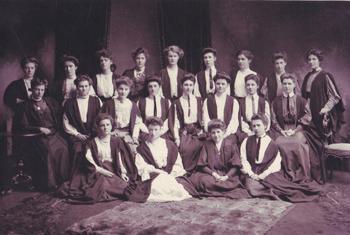


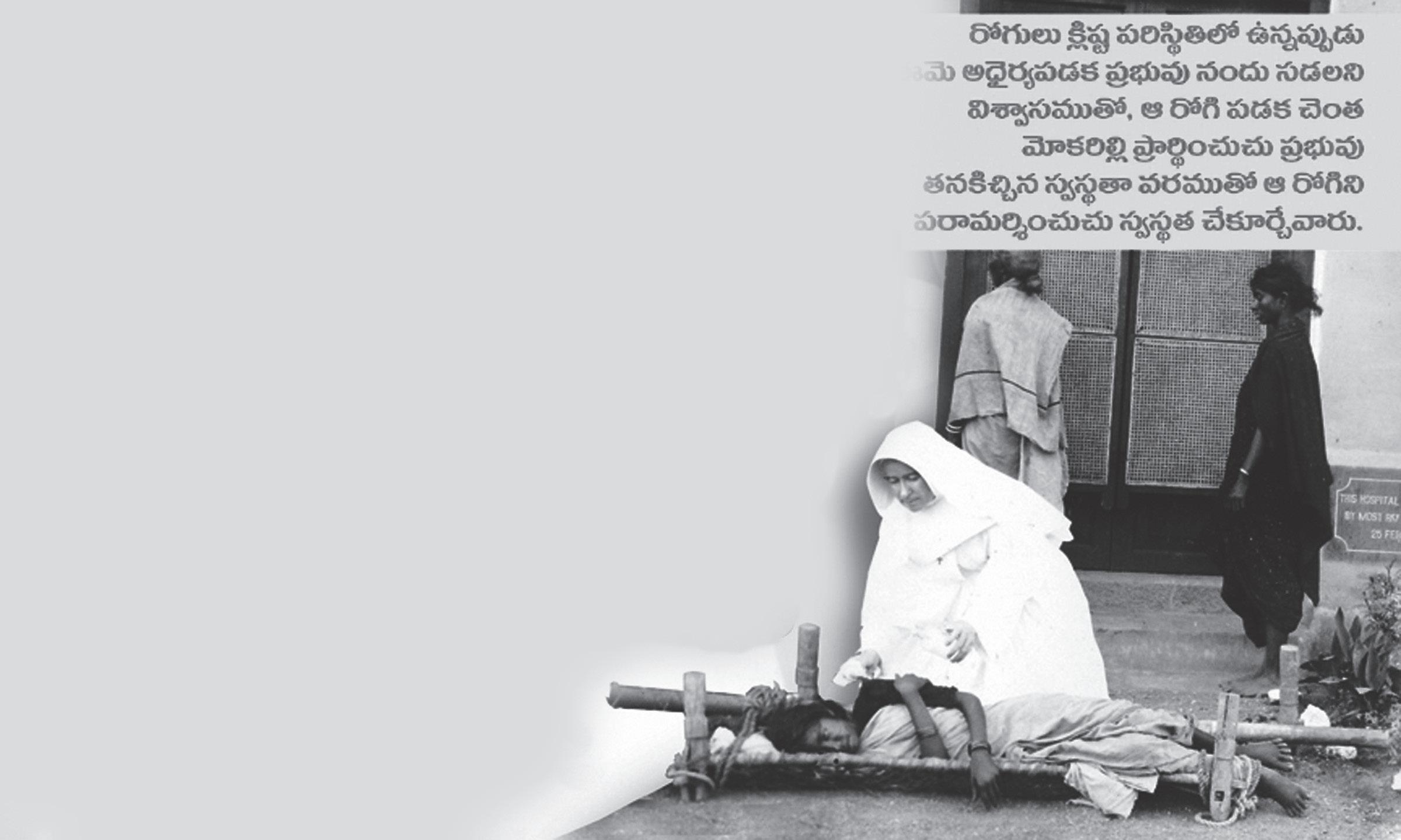



 All images ©Catholic Women’s League of Victoria and Wagga Wagga. Used with permission
All images ©Catholic Women’s League of Victoria and Wagga Wagga. Used with permission
Sr Mary used her modern medical training in combination with traditional Indian medicine, travelling to
• The person has lived a heroically virtuous life
• There is evidence of intercessory power, favours and/or miracles attributed to the person’s intercession
Archbishop Hart said it would be “the commencement of the diocesan phase of the process for possible beatification” for a woman who was said “to radiate Christ by word and example,”

bioethics convenor of the Catholic Women’s League of Australia, said the cause was “gathering pace slowly” in India and Australia in the past decade. She described Glowrey as “an outstanding “The commencement of the preliminary phase of the cause of Dr Sr Mary Glowrey has led to rapidly growing interest in the story of her life both in Australia and internationally,” said Robyn Fahy, a member of the Committee for the Cause of Sr Dr Mary
Father Dan Strickland and Jewell Start, current president of the Catholic Women’s League of Victoria & Wagga Wagga, travelled to Guntur for the beginning of the Diocesan inquiry into her cause for canonisation.
“Day 3 dawned bright and hot, and beckoned us to the pilgrimage part of our journey,” Father Dan wrote of his trip. “We made the hour and half drive past motorbikes, cows, trucks and cars to the city of Guntur, where nearly a hundred years ago Mary Glowrey had started a small clinic to begin the mammoth

task of treating the medical needs of the people of that area, and in particular the needs of pregnant women. The tiny clinic is still there, along with the dispensary, lovingly maintained and still in use for the purpose that Mary originally intended it. The furniture that Mary used remains largely in place, and still stores medication, papers and instruments. Her examining table, too, remains, and is still used to examine patients even today”. The Catholic hospital Mary founded in 1943 has become a multi-faceted operation, the largest NGO in India.
In an upcoming edition of magazine, Jewell Star writes: “One of the highlights of our visit to Guntur was a tour of St Joseph’s Hospital where Dr Sr Mary Glowrey had worked so tirelessly for 37 years. Walking in her footsteps was truly humbling. The places where Mary worked and lived have been lovingly preserved, and there are photos of her throughout the hospital to inspire others working in the JMJ (Jesus, Mary and Joseph) health apostolate. We were also blessed to meet several elderly JMJ sisters who had worked with Dr Sr Mary Glowrey, and cared for her in the final months of her life. Listening to their stories made Mary Glowrey ‘come to life’ for us”. A fellow nun who knew her well said, “It is almost certain that Sister Mary never attempted anything and never finished anything without seeking the aid and guidance of the Holy Spirit… She did attempt the impossible at all times and she tried to inspire others to attempt them also.”

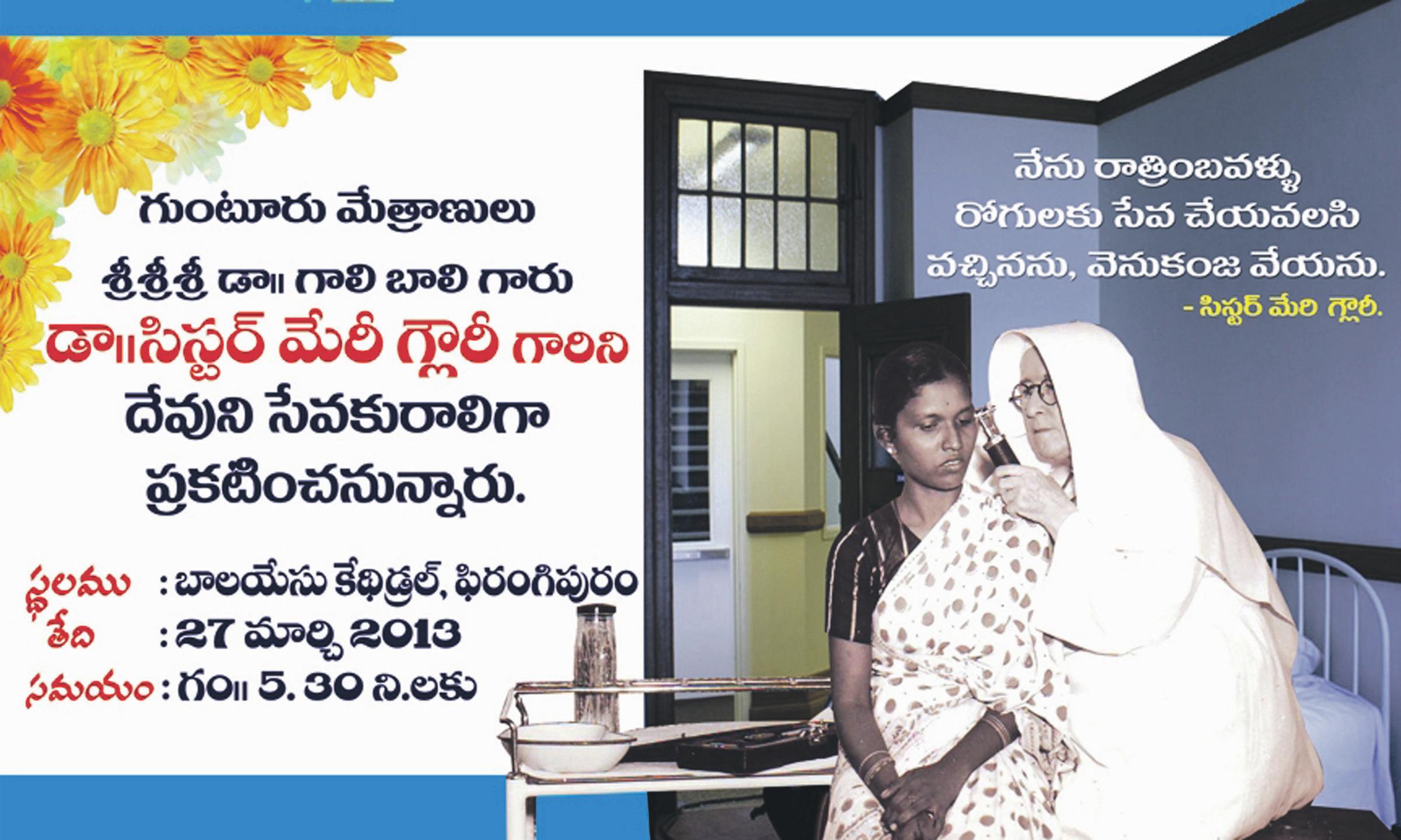
On the 5th of May, 1957 Mary uttered her final words, “My Jesus, I love you.”

She had suffered terribly from cancer in her last few years.
At her requiem Mass, the Bishop of Guntur described Mary Glowrey as a “…special creation of God…a great soul who embraced the whole world”.
If she is canonised, the great Mary Glowrey will be a symbol of the ties that bind Australia and India and a symbol of the power of compassion, love and dignity.

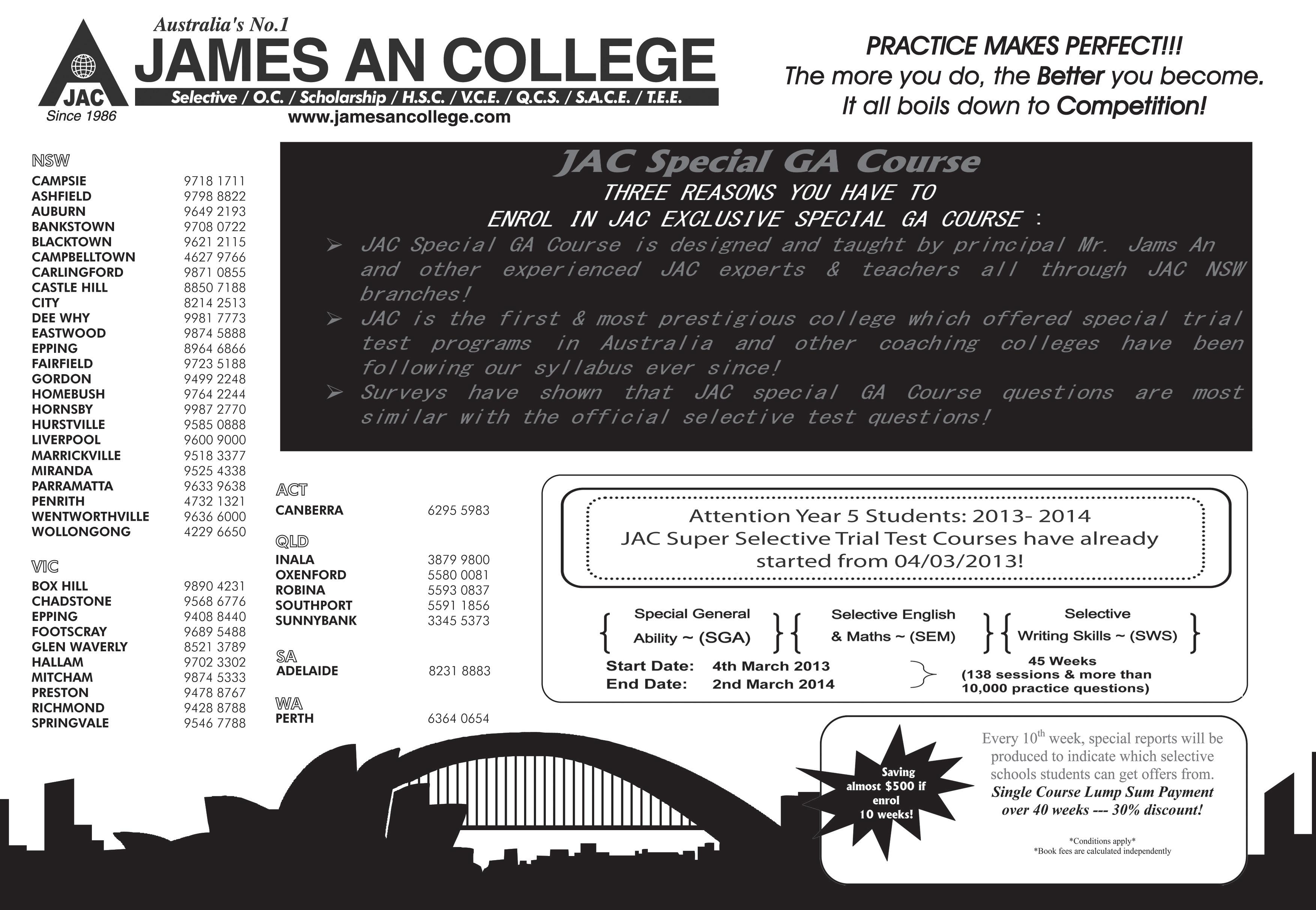


Theoretical physicist Ashoke Sen is one of India’s richest scientists, not just because of his wealth of knowledge on physics, but also because of the $3 million he received recently as the prize for the inaugural Fundamental Physics Award.
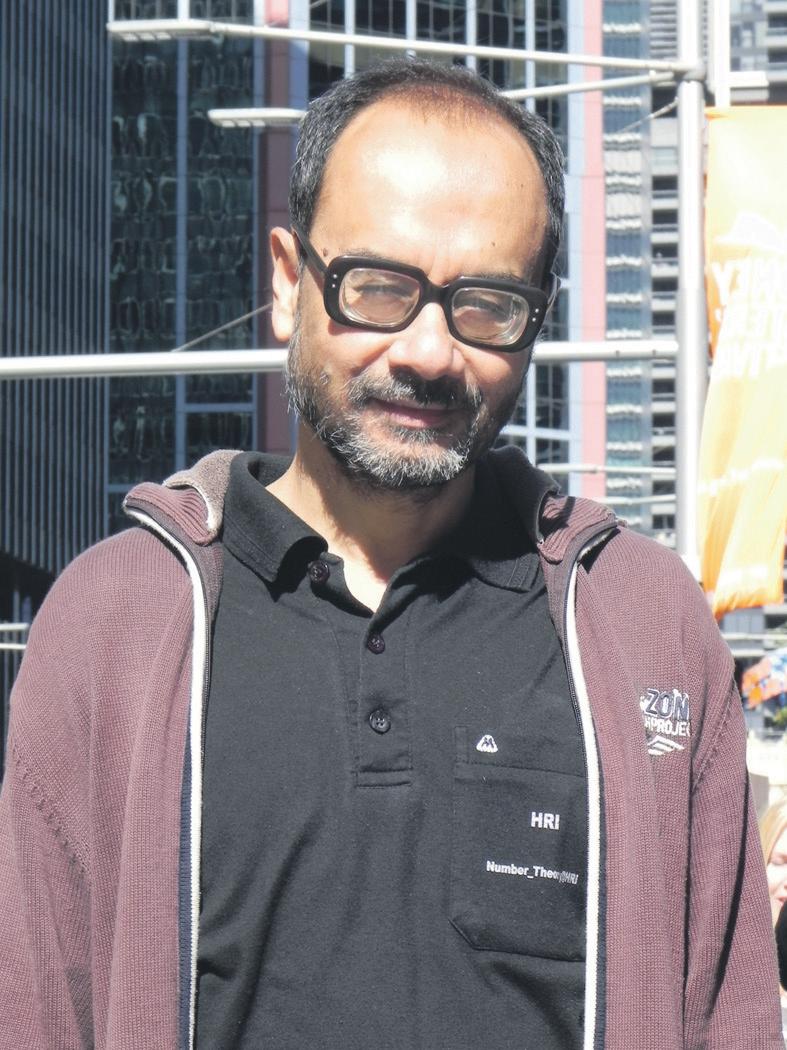
It is awarded by the Fundamental Physics Prize Foundation, a not-for-profit organisation dedicated to recognising physicists involved in fundamental research. It was founded last year by Russian physicist and internet entrepreneur Yuri Milner, and has come to be known as the ‘Russian Nobel’.
Sen was picked for his contribution to “string theory’’.
“String theory is an attempt to understand the most basic constituents of all matter and the forces which operate between them,” Ashoke Sen explained to Indian Link on a recent visit to Sydney. “It is based on the idea that the elementary constituents of matter are not point particles, but one dimensional objects i.e. strings”.
He added, “This theory automatically combines quantum mechanics and general relativity. It also has the potential for explaining the other known forces of nature: strong, weak and electromagnetic forces”.
“Hearing the news, my brain didn’t work for a while,” said Sen, upon finding out that he had won.
“It was definitely a surprise; particularly since such a prize didn’t exist before,” he added.
Yuri Borisovich Milner, a former Russian physicist, is best known in the business world as co-founder and current president of the Russian investment fund Digital Sky Technology. Having hit the billionaire list last year, he is eager to highlight to the world transformative advances in the field of physics.
Milner personally selected the nine recipients for the Award in its inaugural year, of which Sen was one, with each receiving $3 million. This makes the prize the world’s most financially lucrative academic award, beating both the Nobel Prize ($1.2 million), as well as the Templeton
Prize ($1.7 million) combined.
“My colleagues were happy,” says Sen of other’s reactions to the news. “There was excitement in the Indian and foreign media and as expected, lots of interviews”.
Sen is currently an academic at the Harish Chandra Research Institute in Allahabad in India, a Department of Atomic Energy aided establishment. A fellow of the Royal Society of London, he earlier received the Shanti Swarup Bhatnagar Award in 1994, Padma Shri in 2001, Infosys Prize in the Mathematical Sciences in 2009 and Padma Bhushan in the current year.

Born in Kolkata in 1956, his love affair with physics began at the Presidency College, before he moved on to IIT Kanpur, and then the State University of New York Stony Brook USA, where he obtained his PhD.
“In theoretical physics, one can, in principle, work from any place as long as one has a computer and internet connection,” said Sen. This is why, unlike many others, he opted to return and work in India. “Also at present, India has many excellent people working
in string theory. So I think that the facilities and the research environment available in India are more than adequate to carry out research in theoretical physics”. Sen has produced over 200 papers on string theory, at both a national and international level. Sumathi Rao, his wife of 30 years, is also an eminent physicist, and they both work at the same institute in India.
On a lighter note, although Sen is best known in scientific circles for his work on strings, his close friends and fellow physicists also enjoy his culinary and dancing skills.
When asked about how string theory effects our daily lives, Sen replied, “At present it is a purely theoretical attempt to understand how nature works and has no effect on our daily lives. However, as with any scientific development, it is hard to predict how it might effect our lives 100 years from now”.
Sen was involved recently in picking the winner for this year. This year’s Fundamental Physics Award has gone to Prof Alexander Polyakov
of Princeton University.
“All nine awardees from last year reviewed the nominations and came up with a shortlist of three,” Sen informed Indian Link. “A final decision was made in March at Geneva by secret ballots from each of us”.
He added, “There were two other special prizes: one for Stephen Hawking and another for the group at CERN for the discovery of a Higgs-like particle”.
And how is he going to use his own prize money?
“Well, two-thirds of that question is easy to answer,” Sen replied, sounding much like that other famous theoretical physicist Sheldon Cooper of Big Bang Theory. “I’ve paid one-third as tax, and have set aside another third for supporting education in India at various levels. I have not yet decided what to do with the rest; however I don’t intend to do anything to alter my current lifestyle”.
Sen hopes that his award will be an encouragement for young Indian students to take up science as a career option.
At US $3million, the prize is the world’s most financially lucrative academic award, beating both the Nobel Prize ($1.2 million), as well as the Templeton Prize ($1.7 million) combined
At the moment, India has many excellent people working in string theory. The facilities and the research environment in India are more than adequate to carry out research in theoretical physics


 BY NIMA MENoN
BY NIMA MENoN
This month, Ozindcare held their annual Mother’s Day celebration at Granville Townhall to raise money for charity. The cause and the occasion were in sync with each other. It was a cultural extravaganza of music, dance and drama that enthralled the audience, with the evening culminating in a sumptuous meal. It was a celebration of motherhood in all its glory.
Ozindcare, a charity organisation, was initiated by a few like-minded people with a desire to serve the community and ‘help the helpless’. From its very humble beginnings, the organisation has grown substantially over the past few years. Requests for assistance have come even from remote parts of India. This year, assistance was given to 15 families, and among them was a lady who had lost her husband in a car accident and had no one to turn to. Ozindcare bought her a sewing machine and helped set up a small shop to help empower her.
In her address on the night Ozindcare president Anita Kurien spoke of psychologist Marie-Louise Von Franz’s comparisons between western civilisation and Indian civilisation. “Indians are far ahead spiritually and philosophically,” she said quoting Von Franz. “However, she concludes that Indians tend to ignore the plight of their fellowmen... Ozindcare has initiated a pattern in opposition to this where it taps into the social consciousness of people, rising up to the basic tenets of every religion, which is to show compassion and serve the poor and needy”.

The evening began with two Bharatnatyam recitals by Aruna Gandhimathinathan, who is a performing artiste, choreographer and teacher. The Founder-Director of Silambam-Sydney School of Indian Traditional Dance, she received the Distinguished Talent Visa from the Australian Government, and is also a resident-
artist at the Information and Cultural Exchange (ICE HUB), Parramatta.
The two recitals were a celebration of Australia. The Story of Dharawa, depicted the life, culture and art of the indigenous people of the Dharawal region in Sydney, in a cross-cultural collaboration of dance, voice-over and music. The presentation was conceptualised and implemented by the School of Vedic Sciences (Australia) Inc., and was sponsored by the Community Relations Commission for a Multicultural NSW. It was based on Dharawal - The story of the Dharawal speaking people of Southern Sydney, a collaborative work by Les Bursill et.al. Ode to Australia was a celebration of the Australian
land and its people through music and dance.
Through deft mudras, bhavas, raga, tala and natya, Aruna told the audience the story of Australia. Australia, the lyrics said, is also known as the Hira Nmaya Khanda, as it is believed its tectonic plates are made of gold and coral reefs. The lyrics also spoke of Australia as the manidweep bhoomi, the Land of Gems, with varieties of pearls, zirconia, opals and other precious stones found in abundance, along with a plethora of flora rich in medicinal value. The tale cited the 60 rivers with waters rich in metals and alloys that flow through this country. Aruna, through dance and music, spoke to the audience about the kangaroos, the koalas
and the wallabies, the boomerang and the Didgeridoo, which is said to reverberate Omkara. Special mention was made of the vibrant colours rendered by nature, including the red Uluru, the white peaks of the Snowy Mountains and the pulsating reef. She took the audience on a cultural tour of the nation, leaving them spell bound and mesmerised. The lyrics and music were composed by Dr. Meenakshi Srinivasan.
A group of talented artists from Canberra added spice to the evening through a short play about friendship, trust and the ultimate betrayal. The story showed the mother hen with her little chicks advising them about the ways of the world, asking them to be vigilant and
to be aware of the danger that lurks in every corner. A very befitting Mother’s Day show.
This was followed by a jugalbandi The harmonious blend of the flute, the tabla, the Congo drums and the keyboard, to the tune of a beautiful song from a Tamil movie left the audience wanting more. There were some outstanding solo vocal performances too, one of them from the movie Son of Sardar The evening ended with a raffle draw and all prizes (sponsored by generous community members) were aimed to pamper the mums. It was a very fruitful and funfilled evening and a reasonable amount of money was raised for Ozindcare to help those in dire circumstances.


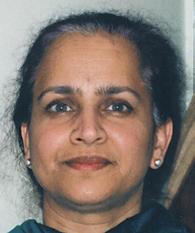
Dr George Michell, author and historian presented a series of talks titled Discovering the Deccan on April 23 and 24, at the Yasuko Hiroaku Room of the Sydney Myer Centre at Melbourne University. Through photographs and slides presented at the talks, the packed and appreciative audience were left with a resolve to surely visit the village of Hampi in northern Karnataka, and in the not-too-distant future. As one who had been to the historic site just a couple of years ago, this writer can only endorse it! There is not another site in India where an entire medieval city and its ruins are preserved to be seen and appreciated.
Dr Michell’s talk was organised by the Australia India Institute in collaboration with the Faculty of Architecture, Building and Planning, University of Melbourne.
Speaking of the Chalukyan architecture, as evident in the area of Aihole, Pattadakkal and Badami, Dr Michell said there was a blend of Dravidian and Nagara styles of temple building. In Pattadakkal itself, some of the temples in the same complex are built in one style, and some in the other. These were built between the 6th and the 8th centuries AD, and one was built by a queen to commemorate the conquest and the sacking of Kanchipuram, which was the capital of the Pallavas, by Chalukya king Vikramaditya. Pattadakkal has now been declared a world heritage site by the UNESCO.
Hampi is the name of the present day village, which was once the capital of the great Vijayanagar Empire, and is also a UNESCO World Heritage site. Introducing briefly the wealth and splendour of the Vijayanagar kingdom, Dr Michell cited the works of Portuguese travellers to the Deccan in the 16th century, who were simply awestruck by the riches they saw, for they had seen nothing like it in Europe. Indeed many maps of Asia available in Europe in the 16th century have only the Vijayanagar kingdoms marked on the maps of India. Until then, the kingdom was the only place where diamonds were available, and that is where Europeans went to buy them.
The ruins of the Vijayanagara kingdom are in a splendid setting

with the rocky and boulderstrewn landscape, with the majestic Tungabadra river flowing through what seems a harsh and inhospitable site. The Vijayanagar kings deliberately chose such a site to protect themselves from the southward march of the Sultanates of the time. The river also provided the water needed for irrigation and agriculture, and by all accounts, the capital alone must have sustained a fairly large population. Several canals criss-cross the landscape and present day canals were built largely on the ancient system. Finally, this was, and is, a sacred site, believed to be the Kishkinda of the Ramayana. Indeed everywhere are reminders of the Ramayana epic: Sugreeva’s cave where the monkeys hid the jewels Sita threw from her vimana as she was abducted by Ravana, the mark on the rock where she had dragged her sari, Hanumantha hill, Raghunatha temple… the list is endless. The Vijayanagar kings also chose the site as their capital for this reason.
Dr Michell pointed out how
temples until the 14th century were built mostly from granite, from this period on, the temple towers began to be built with bricks and mortar, which was much less stable than granite. The Vijayanagar kings built hundreds of temples in Hampi, of which perhaps only the Virupaksha and the Malyavanta Raghunatha temples survived the sacking and destruction in the 16th century, and continued to be places of worship. In terms of architectural and artistic achievement, however, the Vitthala temple and the Hazara Rama temple are the most magnificent. In the latter temple, which was perhaps a private temple for the royals, exquisitely carved scenes from the Ramayana depict various episodes in 108 panels that go in a clockwise direction around the walls of the temple in 3 tiers.
The royal centre has the most wonderful monuments/ruins in a hybrid style, incorporating traditional Deccani and Dravidian styles together with Islamic architecture. The Vijayanagar kingdom was quite cosmopolitan
and there were several Arab and Turkish/Central Asian soldiers and horse traders who perhaps, both served or travelled through the capital regularly, and many of the outer wall panels of the Mahanavami platform depict these. There is even evidence of European soldiers, most likely Portuguese mercenaries, who must have served in the Vijayanagar armies. The stepped tank that was discovered in the mid-1980s by Indian archaeologists is also a marvellous example of Vijayanagar architecture and a product of great building ingenuity.
Dr Michell has made a prolific contribution to scholarship in India, and is regarded as an expert in Indian architecture. He is a graduate of the Faculty of Architecture, Building and Planning at Melbourne University, having received a Bachelor of Architecture degree in the early 1970s, and then obtaining a PhD in 1974 from the School of Oriental African Studies, University of London. Dr Michell’s recent publications include

Dr Michell has made a prolific contribution to scholarship in India, and is regarded as an expert in Indian architectureThe Great Temple at Thanjavur: One Hundred Years, 1010-2010, with Indira Viswanathan Peterson and Bharath Ramamrutham (2010). Musical pillars at Vithal Temple Complex Hampi elephant stables The chariot at the Vitthalaraya Temple



Originating in the temples of Tamil Nadu several thousand years ago, the story of classical Indian dance is a complex one. Quite like the turbulent history of its motherland, this ancient art form underwent periods of growth and decline, before its renaissance in the twentieth century.
Using the parallel, but often contrasting traditions of Bharatanatyam and Kuchipudi, it is this complex tale that talented siblings Sandhya and Govind Pillai chronicled through their dance documentary Sutra – Secrets of Classical Indian Dance
The three hour long production, which included footage from archives (painstakingly collated by Govind Pillai and Adrian Van Ray), in-depth interviews with experts, as well as live dance recitals, was recently staged at Riverside Theatre Parramatta.
A philanthropic venture of Karma Dance Company (in aid of domestic violence victims), Sutra first débuted in New Zealand. Since then it has had encore performances at prestigious venues across Victoria and Tasmania.
What makes the production particularly remarkable is the fact that the artistes involved in the performance were scattered across many cities in Australia and New Zealand, juggling hectic professional schedules in the process.
This time round, Sutra raised valuable funds for fledgling NSW refugee women’s support group, Shakti.
Govind Pillai has enjoyed a long and productive relationship with Sydney audiences. A senior student of Hamsa Venkat, he has often been the centerpiece of her Bharatanatyam productions. With every performance, Govind reaffirms his deep-rooted passion and commitment to this genre.
What sets him apart is his ability to experiment and innovate without sacrificing age-old traditions as laid down in Naatya Shastraa
Interestingly, it was his sister Sandhya, who first inspired Govind to give this “gynocentric” art form a go. While Govind focused on his core skills in
Bharatanatyam, Sandhya chose to additionally explore Kuchipudi and Mohini Aattam Sutra offers the Pillai duo a unique opportunity to compare and contrast the subtle nuances of these traditional genres, while also recounting a broader saga.

Adeptly combining diverse elements, the brother-sister duo explored the entire body of Natya Shastra, appealing to audiences, young and old, amateur and seasoned.
The opening Kauthuvam, a traditional temple dance dating back to 17th century, explored the nuances of Bharatanatyam and Kuchipudi, while highlighting the contrasts.
While Bharatanatyam is a subjective art form, it is equally analytical and firmly grounded on pure mathematical principles. What followed in the Jathiswaram (which is essentially devoid of meaning) was a tribute to the rhythmic patterns, intricate footwork and geometric postures. Govind chose to pay obeisance to a rare composition, the Mysore Jathi to demonstrate the importance of these underlying principles.
Hand gesture, or mudra, is another core element of dance repertoire. Likewise, ranging from compassionate to fiercely protective, female energy is an endearing aspect of Hindu ethos. Exploring complex symbolism of Akhilandeshwari, Sandhya elaborated on the rich body of mudras through Shakthi, the mother goddess’ eight forms.
Testing not just the knowledge, but stamina of the artist, Varnam is the highpoint of any recital. As Govind beautifully summed it up, the Varnam offers a “Substantial body of ideas for the audience to ruminate on”. Govind chose to idolise the much loved but reluctant hero of Indian classics, Hanuman. The staple of every child’s imagination, the story of Hanuman’s quest for the celestial mango was portrayed brilliantly in the Varnam, as was Hanuman’s antics in the palace of the mighty king Ravana. The musical score was a perfect accompaniment to the piece, which reached a crescendo with this varnam. It transcended all linguistic barriers to drown the audience in sheer joy.
The lead vocalists Krishna Ramarathinam, Sangeetha Ayyar and Hamsa Venkat (nattuvangam) were complemented perfectly on the instruments by Anita Das (violin) and Venkat Ramakrishnan (mrudangam).
The magical notes of mrudangam
and violin effortlessly recreated the sounds needed as Hanuman playfully knocked on the pillars of Lanka to create truly enchanting music.
If varnam tests the stamina, tharangam, which is the centerpiece of a Kuchipudi recital, challenges the dexterity and composure of performer. As Sandhya’s feet were delicately poised on the rims of a brass plate, the use of props like burning lamps and a water filled brass pot, placed additional demands on her balance and composure. Sandhya effortlessly proved her mastery over the rhythmic complexities through this demanding item.

Having demonstrated their individual prowess, the duo came together for a memorable piece that celebrated the unique brother-sister relationship. And what better story to tell than that
of Draupadi and Krishna, whose undying affection is celebrated to this day through the sacred Raksha Bandhan festival.
Having delineated the traditional aspects of dance, Govind next chose to integrate broader western concepts in a unique fusion piece. Incorporating elements from Native American to jazz and techno music, he demonstrated the adaptability and resilience of this genre to novel techniques.
The Thillana, another key element of a traditional recital incorporated an element of surprise by introducing Mohini Aattam, or the seductive body movements and facial gestures.
Set in Raagam Dhanyashree to Aadi Taalam, Sandhya focused on elaborate eye movements and graceful gestures. No recital is complete without a chapter on Krishna.
The artistes involved in the performance were scattered across many cities in Australia and New Zealand
Little Sreenidhi Nair, no doubt inheriting her mother’s passion for dance, more than proved her mettle with an elegant performance.
The evening concluded with the customary Mangalam as the artistes expressed their gratitude not just to the divine forces and gurus but the accompanying artistes and audience as well.
Such skilled recitals no doubt speak volumes of the artistes’ commitment to keeping an ancient tradition alive. The flawless dance documentary is clearly the product of hours dedicated to coordinating, choreographing and rehearsing the performance. Kudos to the entire unit, both on and off stage.
The Mandir School of Music (MSM) presented their second annual performance in Canberra on 4 May, showcasing the talent of students under the tutelage of Mrs Ragini Santhanam, the school’s founder and principal.

The theme for this year’s program was Samarpanam - complete surrender to God To explain the concept of surrender is by no means easy, but with Ragini’s expert selection of two stories – that of Nala and Damayanthi from the Mahabharata, and of Saint Surdas – she explored the subject with skill.
The well-planned and executed evening began with an invocation to the gods, through little children reciting shlokas with accuracy and conviction. This was followed by a tableau depicting the story of Nala Damayanthi from the Mahabharata

The entire story was presented using well-decorated puppets, presented by beautiful young narrators and interjected with carefully chosen songs, notable being Swamy Thyagaraja’s cudera celulara in pantuvarali ragam
The second section began with a lilting dance on the song Theeradha Vilaiyattu Pillai, which showed the gopis succumbing to Krishna’s playfulness, losing themselves in his presence. It was also an apt prelude to the next and perhaps the most poignant part of the evening – the story of Saint Surdas. Ragini Santhanam played this lead part, narrating the story in hari katha style. It was an engaging kucheri with a string of kritis, interspersed with an equally captivating narration. Or perhaps it
was the other way around!
“We loved the upanyasa about Surdas and his devotion to Lord Krishna,” said a member of the audience. “The performers did a wonderful job by combining
beautiful songs like Bhajare gopalam, Hey Govinda hey Gopala, Nara jenma bandaga along with the katha Surdas came to life right in front of our eyes, we could feel his pain and also his bliss, when he was able
The well-planned and executed evening began with an invocation to the gods, through little children reciting shlokas with accuracy and conviction
to see the Lord. It was a wonderful idea and in this fast moving world, when we all are so concerned with materialistic things, we need such kind of programs to stop us for a while, and to help us think about the direction and goal towards which we are travelling. And ending it with the beautiful bhajan Mhare ghar aao ji was like the cherry on top of the icing!”
The MSM began in Canberra by Mrs Ragini Santhanam in 2002, with the aim of promoting Carnatic music within the Canberra community. It has since grown and now boasts of students from all age groups with varying levels of competence. Along with classical music, Ragini Santhanam also teaches shlokas to those interested.

It is said that to learn you need perseverance, and to teach you need patience and temperament. Samarpanam was testimony to the fact that those skills are abundant in the MSM.
Radha RaviThe second section began with a lilting dance on the song Theeradha Vilaiyattu Pillai, which showed the gopis succumbing to Krishna’s playfulness, losing themselves in his presence

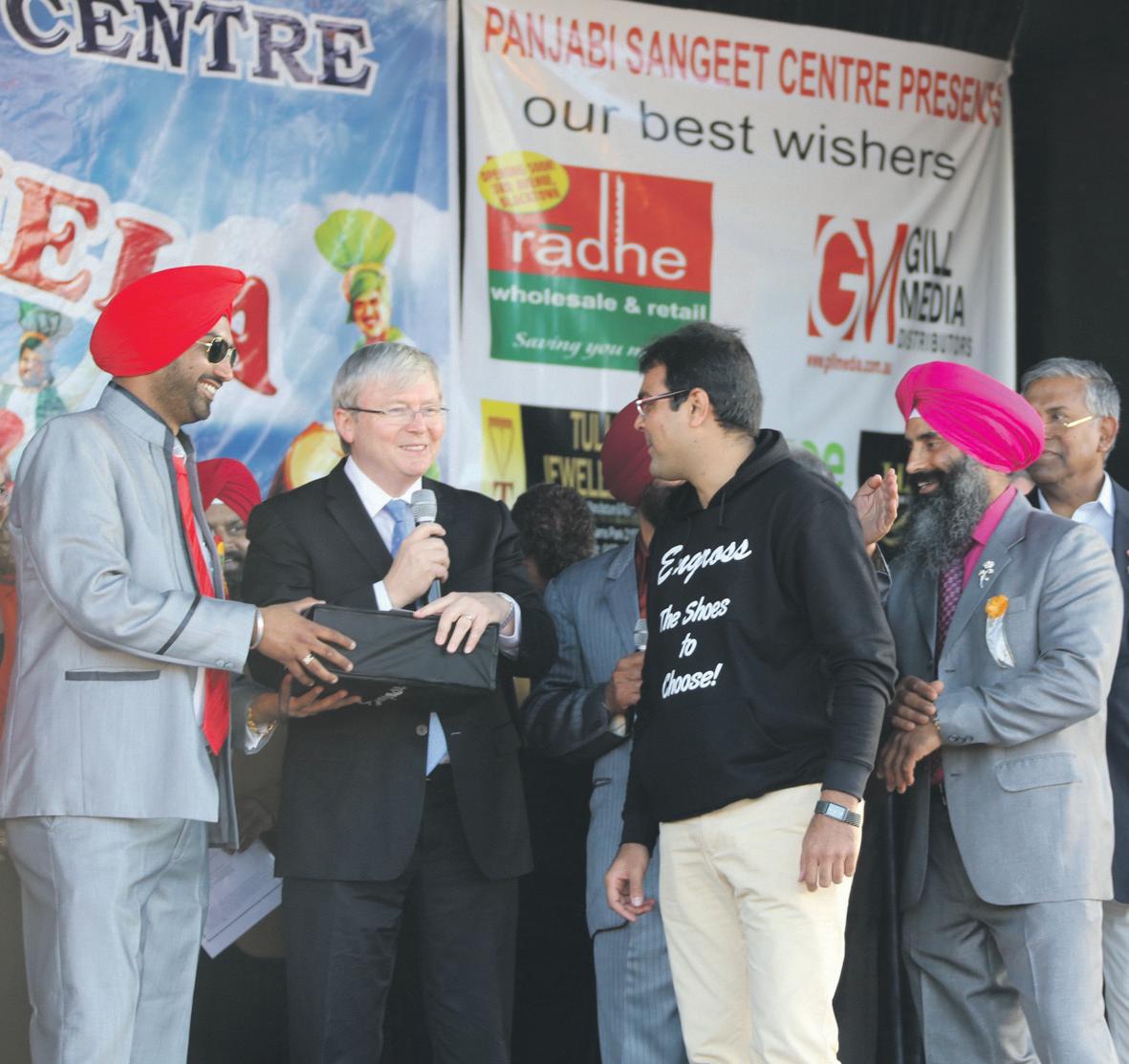

especially the traditional makki di rotti and sarson da saag
BY KOMAL JAGAD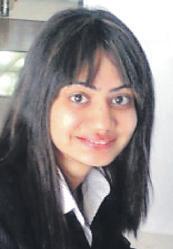
The traditional crop festival of Punjab, Vaisakhi has grown over the years to become one of the Punjabi people’s most keenly celebrated events. Far they may be from the fields of agrarian Punjab, but the Punjabis of Australia party anyway on this occasion. The leafy green fields of Blacktown Showground played host to the Vaisakhi Mela (Fair) this year. What better way to mark the New Year of the Sikh community, than to have a day in the sun with music, fun, food and jollity.


Sydney’s Panjabi Sangeet Centre has been organising the Fair for the last 24 years. This time round, it was merriment everywhere as nearly 10,000 people, all from mixed backgrounds, hailed the cultural fiesta, the food stalls, the dance performances, the congregation of communities and much more.
A hearty invocation to God with beautiful Sikh prayers initiated the ceremony at 10am. The event was inaugurated by former Prime Minister Kevin Rudd, reflecting the importance of multiculturalism and celebrating Australia’s cultural diversity. President Harkirat Sandhar and Director Devinder Dharia from the Panjabi Sangeet Centre were instrumental in organising the festival with a prime focus to promote Punjab’s rich culture.
With dhols playing in the background, the mood was set for the party. A series of performances and songs entertained the crowd soon after. 400 participants with 50 different performances filled the day’s schedule. Bubbling dancers like the Aakriti Group, Hasrat Sandhar and Raunak were encouraged for their Bhangra, Gidda and Bollywood dances and so were the singers like Sonu, Bablu, Gurmail Singh, Saleem and Sukh Dharia. It was Jhoom Barabar Jhoom time when Bollywood chartbusters such as Ishq Shava from Jab Tak Hai Jaan, Chammak Chalo from RaOne, Radha from Student Of The Year got everyone to go shaava shaava.

The food stalls serving Indian delicacies had taste buds twirling
Donning sequined Anarkali styled suits and colourful kurtis, the venue turned into a reflection of vibrant rainbowed hues.
The kids were kept suitably occupied with a jumping castle, a dashing car arena and a merrygo-round, as parents got involved in a bit of their own play: musical chairs, tug-o-war and Chatti Race (a ladies’ race while balancing an earthen pot on the head). Traditional touches like Chatti Race are the key to such congregations. The Chatti Race was a novel event for the kids, who have not had a chance to witness Indian festivals at their origin, although they would know about Quidditch from the Harry Potter world. Unraveling our tradition to the little ones is an integral part of these cultural fairs.
A lot of community support was extended to emphasize this.
Attending the celebrations were Parliamentary Secretary for Multiculturalism Senator Matt Thistlewaite; Members of Parliament including Michelle Rowland, Ed Husic, Nathan Rees, Julie Owens and David Elliott; first Punjabi minister in Canada Parm Dhaliwal; and others including Harish Velji, Karnail Singh, Ejaz Khan, Amarinder Bajwa, Mansoor and Pravez.
A big pat on the back for the Panjabi Sangeet Centre for their continued efforts in promoting the best of Punjabi culture here.
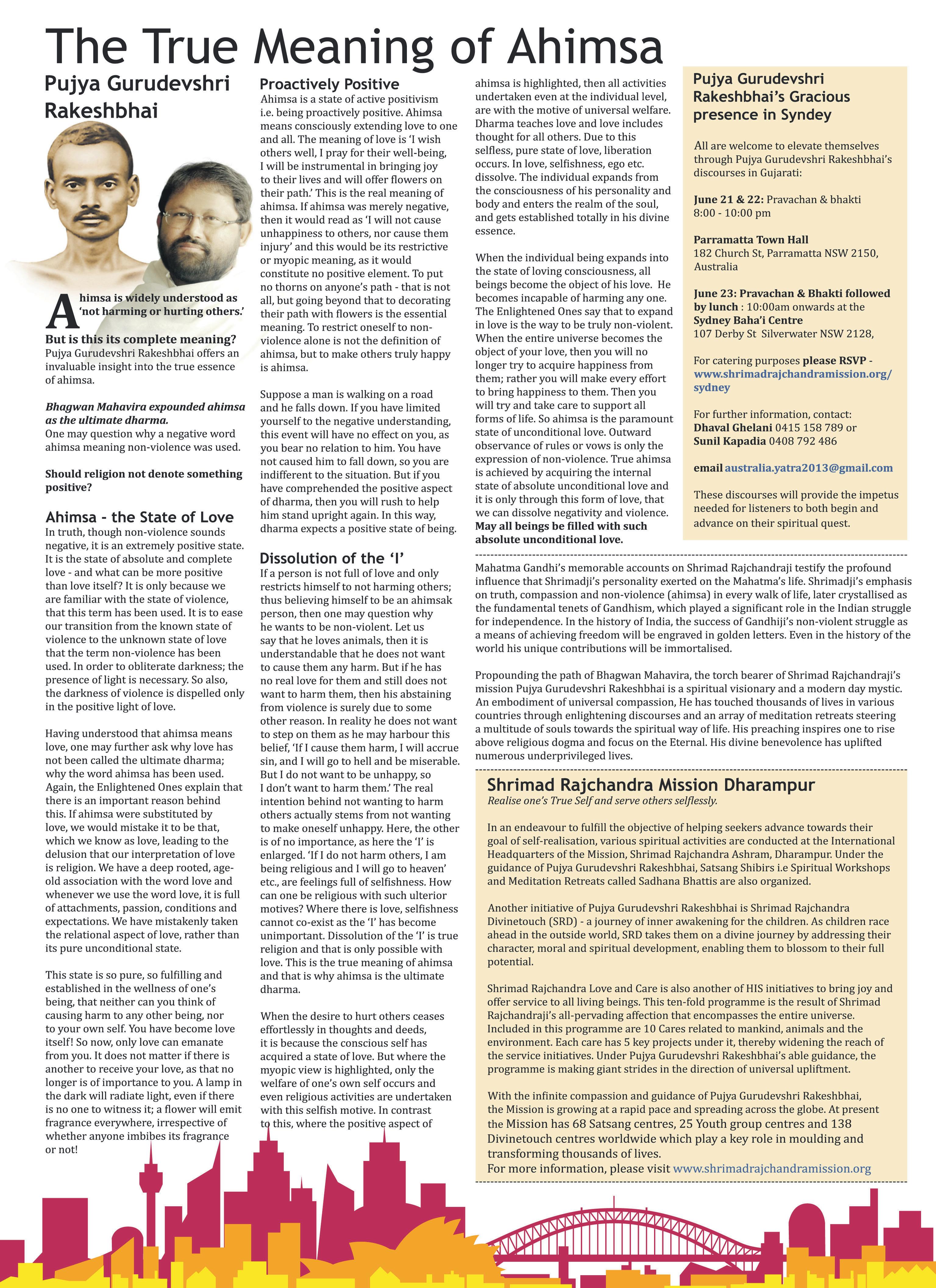

respectively, and allege that each player knew of the others’ involvement.
BY RITAM MITRACricket once again finds itself shrouded in controversy, and for the second time in as many years, it is the IPL at the centre of the crisis. Sreesanth, Ajit Chandila and Ankeet Chavan, all representatives of the Rajasthan Royals franchise and members of Ranji Trophy teams, were arrested on May 16 for their alleged involvement in a spot-fixing scandal that has resulted in the now customary effigy-burning, widespread streetside protests and the assurance that if found guilty, the accused will be dealt with severely. The only thing missing, as usual, is the promise of a solution.
Spot-fixing, which involves the fixing of an outcome within a match rather than fixing the result of the match itself, famously came into the spotlight in 2010, when a News of the World sting operation secretly videotaped bookmaker Mazhar Majeed promising a set of no-balls on pre-determined deliveries bowled by Pakistani quicks Mohammad Amir and Mohammad Asif. The following year, the duo, along with captain Salman Butt, were found guilty, and were sentenced to between 6 and 32 months in prison.
Last year, five IPL players were suspended by the BCCI for various offenses, including negotiating fees for bowling noballs in the IPL, as well as ‘loose talk and unsubstantiated bragging’.
Sreesanth, Chandila and Chavan stand accused of agreeing to concede a minimum amount of runs per over. They were alleged to have been promised between US$36,000 and $109,000 per over. While investigating leads that suggested that the Mumbai underworld was indulging in spot-fixing, Delhi police chanced upon evidence that suggested the three players were involved. After keeping the players under surveillance, the investigators waited for the right moment to pounce, arresting them at different locations. Police have filed cases under section 120b and 420 of the Indian Penal Code, relating to criminal conspiracy and cheating
The three matches in question took place on May 6, May 9 and May 15. On May 6, Chandila conceded the agreed-upon 14 runs in the second over of his spell, but failed to give the signal the bookmakers required of him – looking skywards and lifting his shirt. This meant that the bookmakers couldn’t place their bets for fear he’d back out – and they demanded a refund of the money they’d given him in advance.
On May 9, Sreesanth was told to put a towel in his trousers before the start of his second over, and spend some time placing the field and stretching so as to give the bookmakers enough notice to place heavy bets. He conceded 13 runs off his second over – one short of the agreedupon 14 runs, but bookmakers usually keep a one-run cushion in case things don’t go completely right. On the last ball of the over, Sreesanth appeared to move his hand away from a badly-timed Gilchrist straight drive.
In the final match under allegation, on May 15, Ankit Chavan was asked to give at least 13 runs off his second over. After conceding just two runs in his first over, Chavan gave the signal indicating bets were on for his second – fiddling with his wristband. He conceded 14 runs off just the first three balls of his second over – but the rest of the over went for only one run.

The problem with spot-fixing is that it is so difficult to track. In the spot-fixing scandal of 2010, bookmaker Mazhar Majeed assured the undercover journalist that there would be no signal ahead of the pre-determined no-balls. Meanwhile, the signals in the most recent scandal were so nondescript, they could never have been considered suspicious.
It is no longer an excuse to say players are uneducated about the dangers of spot-fixing, or were forced to do so in order to make a living. It is for this reason that Sreesanth in particular, has raised the deserved ire of the public, given his status as a former Indian Test player and World Cup champion currently on an IPL contract of $400,000 for two months of cricket. It is embarrassing to now hear an
It is no longer an excuse to say players are uneducated about the dangers of spot-fixing, or were forced to do so in order to make a living
interview Sreesanth gave in 2011 regarding the Pakistani spot-fixing scandal, where he says, “Even I know nothing like that is going to happen to Indian players for sure, because I think we are surely, either the way we are brought up…we are much more educated in that process”.
Clearly the education didn’t pay off for Sreesanth. His father may accuse MS Dhoni and Harbhajan Singh of conspiring against his son, but as Delhi police so eloquently put it, Dhoni didn’t put the towel in Sreesanth’s pants.
Spot-fixing cannot be put down to the fact that betting is illegal in India; there is no way to fully eradicate corruption in any major sport. For instance, the Pakistani spot-fixing scandal took place in the UK, where there are legal markets for gambling on sport.
The solution is not as simple as increasing the powers of the Anti-Corruption Unit, or putting stricter penalties in place and legalising betting. The law can only do so much to deter wouldbe cheats. The sad fact is, human greed often triumphs over good sense in people of weak character – and they’re only ever apologetic
if they get caught. It is the height of irresponsibility, selfishness and stupidity for these individuals to take away from a game that has given them everything they have; yet there is very little that might have deterred them other than the fear of being caught.
As a comparison, you do not avoid stealing purely because you fear being caught – it is simply wrong.
The most haunting aspect of spot-fixing for convicted fixers must surely then be the thought of cheating hundreds of millions of followers, or having to explain to their children, either now or in future, why they are not playing cricket anymore, or why stones are being thrown at their home and photos of them are being burned by angry mobs. And it is perhaps this moral culpability that must be more focused upon in the players’ education. In the age of social media, it’s become much easier to reach the celebrity; if proven true, these allegations will change the lives of three young men forever.
If found guilty, Sreesanth and his co-conspirators must be dealt with severely. But how many cases will it take to set an example?
It is the height of irresponsibility, selfishness and stupidity for these individuals to take away from a game that has given them everything they have; yet there is very little that might have deterred them other than the fear of being caught
Spot-fixing, which involves the fixing of an outcome within a match rather than fixing the result of the match itself, famously came into the spotlight in 2010
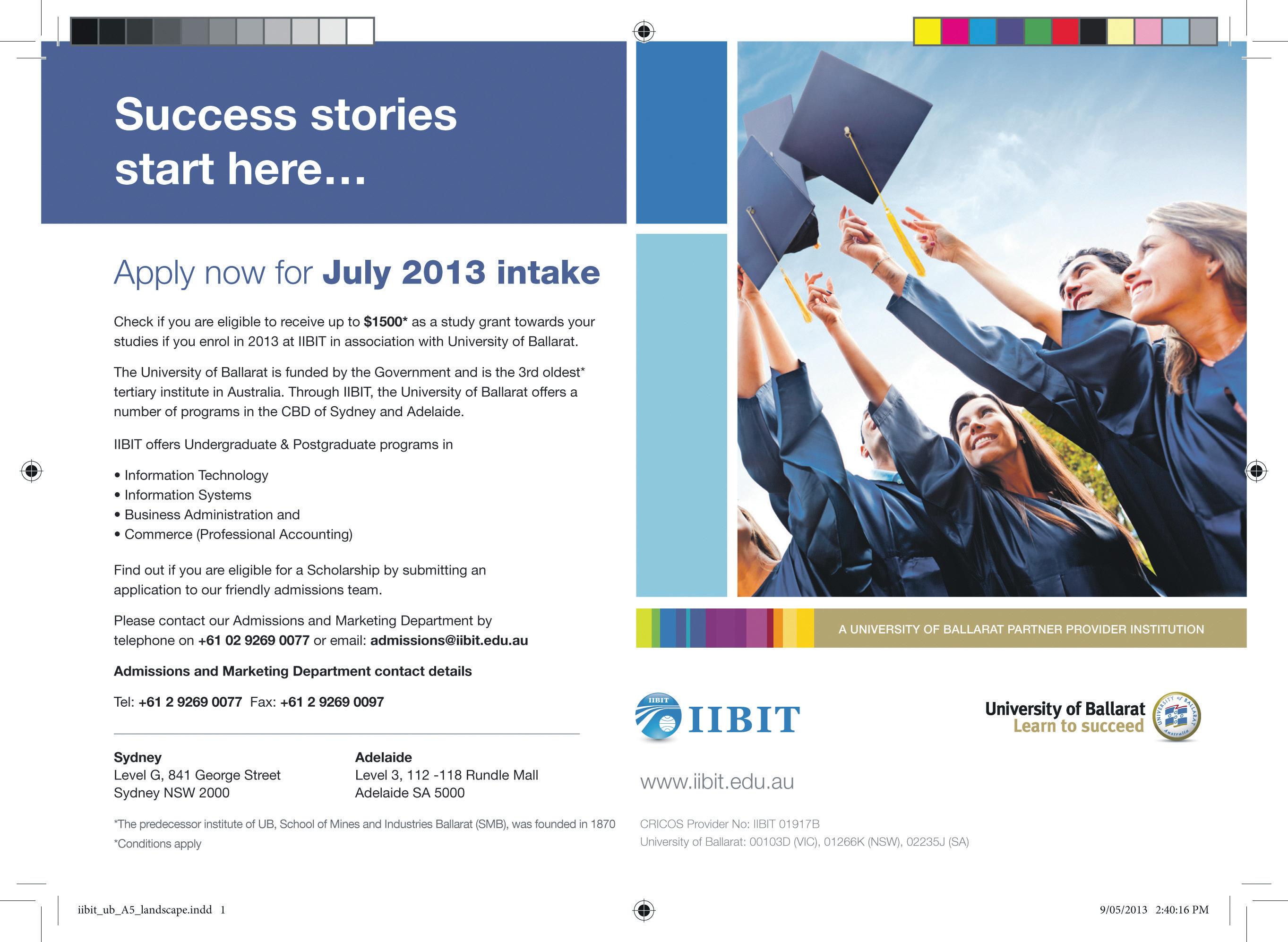

Course Admissions (Australia wide), Student Visas, Work/ Sponsorship Visas (457s, RSMS, ENS), Partner Visa, Family Visa, Tribunal Appeals & Waivers, General Skilled Migration.
• Ramneek brings in vast knowledge & experience of having worked many numbers of years in this industry to each case he takes up. This added with absolute professionalism & his responsiveness makes him one of the best in this industry. Ramneek brought all of these qualities to bear in my case to ensure that case was represented rightly with a successful outcome after stalling for almost 2 years prior to him taking the case up
• – Alex, IT Manager, Sydney (457 Visa to PR)
• Ramneek helped me to sponsor couple of employees on 457 visa for my business...was extremely professional, always available provided necessary info. We appreciate his work & would recommend him to anyone - Navjas P/L, North Ryde
• If you want excellent customer service & prompt responses to any of your questions, then TGLT is your stop. Highly professional & friendly migration agent!! – Mrs. Michele Elkan, Shizam Enterprises P/L
• Thanks for handling my Partner Visa case…with S48 on our application...we got the grant of permanent visa in less than 10 days - Priyanka, Parramatta
• I am really happy with the services. He handled my case very well. – R. Kaur (Student Visa to 457), Echuca, Victoria
• Very courteous attentive service. I had a few issues for my visa due to time restrictions but it was handled very professionally without a glitch…great customer service professionalism. Thank you for all your extended help efforts, highly appreciated.
• – S.M. Athar (SC 457 visa), Windsor
• He knows exactly what is required & gets the results. I would recommend all to take his services. Thank you. – Pujan Sheth (457 Visa)
• For all your hard work you done & your timing advice, really helped me in getting my PR…thanking you from bottom of my heart - K. Singh, Glenmore Park
• I withdrew (my) first 457 visa application…& I got it the second time with Ramneek’s help. Thank you so much. – C. Koppela, Homebush
• Ramneek, handled our matter in a very professional way…was precise with what he wanted…his knowledge is deep accurate. I felt very comfortable.
– Shree Ram P/L, Lidcombe
• Because of his sound knowledge & experience, my 457 has been approved within 2 weeks. I would highly recommend – R. Gaur, Bikaner
• Many thanks for acting promptly when needed. – K. Patel, 457 Sponsor, Sydney
• Thanks for the efforts you put in for this achievement - T. Kaur & N. Singh (SC 475 to PR)
• I consulted couple of agents was very disappointed as they were very much sure that there is no 457 I was not eligible for that. This is a special note for thanking Mr. Ramneek for helping me throughout my 457 visa process.
– M. Ramakrishna Jeksani, Homebush
• We were hopeless after our initial application was mismanaged. Now I got it successfully within 4 weeks my grant which was done skilfully without any questions from case officer, Thank you Ramneek. – S. Kola (SC 457 visa to PR), Liverpool
• Has understanding of the system & very helpful. He is reachable & responds to the queries very well. – Narendra Gupta (SC 457 to PR), Ashfield

• Everyone thought that I won’t get my 457 visa....thank you for making my application successful. – S. Rao, Casino
• You have been excellent in handling our case & all its difficulties including my daughter who has already turned 19. – K. Sanyasi (457 visa), Warwick Farm
• I am really very thankful & overjoyed... lead me through the toughest situation to final success. – N. Singh, Mohali, India.
• Thanks lot for my sponsor (457) visa. It didn’t look possible, but I got it finally with Ramneek’s help & guidance. – Kiran Kumar Patel, Harris Park
• My 457 visa is granted. Thanks for the co-ordination, Ramneek Sir. – R.T., Cook, Westmead
• I was on a bridging visa... & I got my 457 visa within 28 days & without leaving Australia
– Amandeep Kaur, Merrylands
• Everything was well planned & Systematic. Must recommend for Immigration issues.
– H. Gandhi, 457 Visa, Merrylands
• I got my 457 work-permit (from student visa) within 4 weeks. Mr. Ramneek done his work very accurately, on time, without any failure & provides perfect guidance. I am very happy with his work & very thankful to him. – Chirag Patel, Kew, Victoria
• I was able to negotiate through the complicated process & retain a baker full time in my business. For 457 working visas, Mr. Ramneek Madahar’s services are highly recommended. Definitely a 5 star service. – Harry, Bakery Owner, Oatley
• We really appreciate Mr. Ramneek’s support for my 457 visa application. He was very organized prompt, which we believe lead to successful & quick outcome even though we are a newly established company without much financial result.
– H. Uzumasa, Penshurst
• I sincerely appreciate the time you spent reviewing my case as it became complicated due to time frames. Your advice was very helpful & gave me a new hope. Finally, I got my PR. Thank you so much for your help. – Vikas, Homebush
• Ramneekbhai, thank you so much for your help. I got my 457 visa… excellent service, thanks - Krushnakumar Patel, Parramatta,
• Ramneek Sir handled my SC 190 visa & I got approval within 4 weeks of lodgement. I acknowledge my deepest thanks for his fabulous work. – A. Shah, Perth
• I would like to express my sincere thanks to Ramneek Sir for his well done work in getting my PR. – M. Marediya, Perth
• Has impressed me with the accuracy of his guidance & the time frames he gave us for our (Sponsorship/457) applications were spot on. I personally recommend anyone to use his services. – Sana Glass P/L, Lansvale
• Thank you very much for your support while organizing the sponsorship application for our employee. We are very pleased with your work ...will confidently recommend you & your company to our business partners & friends.
– Vaucluse Auto Repairs P/L., Vaucluse
• Ramneek handled my sponsored migration visa with precision of a surgeon. I reckon, my application’s short processing times was owing to Ramneek’s immaculate understanding of the process, sharp eye for details in reviewing documents presentation of the case. The first check list for submission that was customized for my professional background situation) that Ramneek provided served as the ultimate guide in assembling the application. All my queries were answered in less than 24 hours. Such professionalism efficiency made my visa process a breeze… highly recommended for anyone serious about his/her immigration plans.
– V. Srivastava, Melbourne
• Initially, I was a bit doubtful whether my company will get the (457) sponsorship or not because mine is a small company. Thank you very much for your hard work & guidance.
– Prime Partners P/L, Casino, NSW
• Thanks for the effort taken in securing Ganga’s work (457) visa. I know it was a difficult case, much appreciated, thanks. – Dhaya Chandra P/L, Sydney
• Very satisfactory service provided by Mr. Ramneek Madahar regarding my visa complications. – P. Singh, Ellenbrook, WA
• After 8503 (no further stay), condition waiver, my student visa was refused. Thank you Mr. Ramneek for a successful appeal at the Migration Review Tribunal without a hearing. – P.D., Glenmore Park
• I am really very thankful & overjoyed... lead me through the toughest situation to final success. – N. Singh, Mohali, India
• I was finally able to receive confident & correct advice in relation to my situation from Mr. Ramneek Madahar. – G. Bastola, 457 Visa, Homebush
• Thank you for your timely assistance with our restaurant sponsorship 457 visa grant.
– CH Patel & DC Patel, Camberwell, Victoria
• Ramneek Sir has made our 457 visa 100% successful. Thank you forever.
– Shruti Shah, Merrylands
• I was a student in Australia. Mr. Ramneek helped me for a 457 visa.
– Chaudhari Prakash, Ashfield
• I was on a Bridging visa for my SC885 visa application on 110 points. Mr. Ramneek made my 457 visa possible. – C. Patel, Merrylands
• For any complex cases, to anyone who needs help in immigration... don’t worry you are in safe hands. – A.H., 457 Work Visa, Cronulla
• I sincerely recommend Mr. Ramneek’s services for immigration.
– K.K. (457 to PR), Central Coast
• Thank you Ramneek, I wish you all the best. – S. N., GSM Visa, Egypt
• Mr Ramneek Madahar, thank you very much for our PR. Your efforts are appreciated & thanks for looking after my case.
– D. Patel, Business Skills, Melbourne
• I am thankful to Ramneek for my permanent settlement in Australia.
– Vikas, GSM, Parramatta
• I applied for Regional - SC119 visa under the DRC… Mr. Madahar has handled my application very well. – Vijaya, Bourke, NSW
• Thank you Mr. Ramneek for my ENS PR under exceptional circumstances.
– S. Kumar, Croydon (457 to PR)
• Thank you for your support & help towards my ENS PR. – S. N. (457 to PR), Ingleburn
• I am very thankful to Ramneek Sir for his help & support for my ENS residency. I had no hopes left & was planning to go back to India with my family.
– K. Shah (457 to PR), South Strathfield
(Ramneek Madahar, RMA# 0428459)
India and China scripted a new chapter in their ties on May 20 as Premier Li Keqiang and Prime Minister Manmohan Singh candidly discussed their recent border row and decided to take steps for an early resolution of a dispute that triggered a war in 1962.
Li, making New Delhi his first halt in his foreign trip after assuming office in March, and Manmohan Singh also agreed that the world’s two most populous nations and biggest economies have a lot in common despite some known differences.
India’s ambassador to China S. Jaishankar, meanwhile, admitted that the Sino-Indian boundary dispute was complicated and needed a detailed examination. “The issue was discussed at length,” he said, but did not give details.
Both sides inked eight agreements, including on conducting the Kailash Mansarovar Yatra with China to provide better facilities for pilgrims, and four agreements to boost Indian shipments of buffalo meat, fisheries and pharmaceuticals to China, and help reduce the trade deficit.
A joint statement issued after their meeting stressed on maintaining peace and tranquillity along the border and on boosting trade ties.
Li arrived in New Delhi on the eve of May 19 and held two rounds of talks with Manmohan Singh - the first was over a private dinner on the same day, and then formally on May 20. It was Manmohan Singh’s first meeting with the Chinese premier. He had held talks with President Xi Jinping at the BRICS summit in Durban, South Africa, in March.
Chinese troops intruded 19 km across the Line of Actual Control - de-facto Indian border - April 15 and pitched tents, raising tensions between the two countries. The row ended May 5 after many rounds of negotiations, with both sides reverting to their previous military positions.
As expected, the episode came up at the Li-Manmohan Singh talks.
Manmohan Singh told the media along with Li that they held “wide ranging and
candid discussions” on all matters of mutual concern and realised that there was “a great deal of meeting of minds”.
Li echoed him, saying India and China were “strategic partners and good friends” that could speak to each other with candour, while stressing on discussions on the border issue and river waters.
Manmohan Singh said the two countries’ special representatives would meet soon to discuss the border dispute.
“We agreed that our special representatives will meet soon to continue discussions, seeking early agreement on a framework for a fair, reasonable and mutually acceptable boundary settlement”.
Manmohan Singh said both leaders “Took stock of lessons learnt from the recent incident in the western sector” of the Sino-Indian border, and that the “existing (border) mechanisms proved their worth”.
India and China fought a border war in 1962. But over the past quarter century, both countries have steadily built up their relations despite the unsettled frontier dispute.
Li said China and India had worked to “Maintain tranquillity and peace in the border areas” and added that “We need to improve border mechanisms... make them more efficient” as well as “resolve our differences”.
Manmohan Singh also raised India’s trade deficit with China and Indian concerns over Beijing’s decision to build dams over the Brahmaputra river in Tibet that flows into Arunachal Pradesh and Assam.
India asked China to provide greater market access to help lower the widening trade deficit. At the same time, India invited increased Chinese involvement in Indian infrastructure and manufacturing sectors.
India-China trade touched $66 billion in 2012, from $3 billion in 2000. But the balance of trade favours China. In 2012, the trade deficit widened to $29 billion.
On river waters, Li said China had in recent years shared “hydrological information” with India.
“We have had multiple, friendly, in depth and candid discussions. The most important outcome of these discussions is that the
leaders of the two countries have reached strategic consensus and deepened strategic trust,” said Li.
“Since we are strategic partners and we are good friends that can speak to each other with candour, so we do not deny that there are some problems between the two sides,” the visiting premier said.
The two leaders discussed ways to link India’s northeast with Bangladesh, Myanmar, China and countries in Southeast Asia.
Manmohan Singh said he hoped to visit China at the earliest.
Li, who is heading a large delegation, now goes to Mumbai, India’s financial and entertainment capital, from where he will fly to Pakistan, Switzerland and Germany.
Two veteran journalists - Kuldip Nayar and N. Ram - have been selected for this year’s ‘RedInk Lifetime Achievement Award’ instituted by the Mumbai Press Club, an official said in Mumbai recently.
Maharashtra Governor K. Sankaranarayanan will bestow the awards on them and 20 other journalists who have won it in different categories, at a special function on May 25.
They were selected by the club based on a survey of leading and senior journalists from all over India.
Nayar is a renowned columnist and peace activist, a former Rajya Sabha member and a former Indian High Commissioner to Britain.
Ram, who headed The Hindu Group for over two decades, has been accorded Padma Bhushan by the Indian government and Sri Lanka Ratna by the Sri Lankan government.
“It is a privilege to honour such distinguished journalists at the RedInk 2013 Awards. Their contribution to the media and professional achievements speak volumes and serve as a motivation to us all,” said Mumbai Press Club president Gurbir Singh.
This year, the RedInk Awards received over 900 entries from all over India in categories like business, politics, crime, sports, media and entertainment, health

and environment, TV story, science and innovation and photo-journalism.
India and Britain have signed an agreement for cooperation in the health sector with specific focus on strengthening primary health care and technological development, an official said in New Delhi recently.
A memorandum of understanding was signed between union Minister for Health and Family Welfare Ghulam Nabi Azad and Britain’s secretary for health Jeremy Richard Hunt recently at Geneva, the official said.
Describing the agreement as a historic event and a great milestone, Azad noted with optimism that this agreement is going to usher in a new era of cooperation in the health sector between the two countries. Azad said that the agreement between India and Britain will promote wide-ranging cooperation in the health sector between the two countries and spur the exchange of information and expertise for the common good of people.
Some of the focal points of the agreement were promoting exchange on health-care policy in India and the Britain, human resources for health, regulatory issues, health technology development, primary health-care and strengthening of public infrastructure and capacity, the official said.
India has been a recipient of Britain’s bilateral assistance in the form of grants since 1975.
The priority for the partnership has been improvement of maternal and child health and reducing the burden of communicable diseases.
The health minister noted that the signing of this agreement demonstrates the commitment of both the countries to work closely with each other to further cement their strong relations.
An 18-year-old Indian-origin girl in the US has developed a potentially revolutionary device that can charge a mobile phone in just 20 seconds, a media report from Washington said.
The charging device has been dubbed a supercapacitor by Esha Khare of Saratoga, California, the Daily Mail reported.
Khare won $50,000 for her invention at the Intel International Science and Engineering Fair, held in Phoenix.
Khare has only used her supercapacitor to power a light-emitting diode (LED), but says that one day her invention will power cell phones, cars and any gadget that requires a rechargeable battery.
Asked what inspired her to work on the technology, Khare said: “My cell phone battery always dies”.
“It has a lot of different applications and advantages over batteries in that sense,” she was quoted as saying.
The supercapacitor is flexible and tiny, and is able to handle 10,000 recharge cycles, more than normal batteries by a factor of 10.
Khare is a student of nanochemistry, and is now heading to Harvard.
Google has been in contact with Khare to explore how she plans to change the makeup of cell phone battery life, the report said.
Fast bowler S. Sreesanth began shouting and claimed he had close connections with the Kerala and Maharashtra chief ministers after he was accosted by police for alleged spot fixing.
Sources claimed that Sreesanth was with a woman companion in an SUV outside a five-star hotel on Carter Road, Mumbai, when a team of Delhi Police intercepted them.
“When a police officer showed him his identity card, initially he kept silent. But suddenly he started shouting and said that he knew the chief ministers of Maharashtra ad Kerala. How can they arrest him, he demanded,” a source said.
He also handed over his mobile phone to the police officers asking them to call the chief ministers.
Police sources said Sreesanth was drunk at the time of his arrest and he mistakenly thought he was being detained for drunkenness.
Sreesanth, 30, is in the custody of Delhi Police Special cell in connection with the spot fixing scandal busted with his arrest on May 16. His two Rajasthan Royals teammates Ankeet Chavan and Ajit Chandila and 12 bookies have also been arrested.
Armed with “scientific evidence” that the African cheetah is “not an alien species” and can survive in India, the government is planning to petition the Supreme Court to allow the import of the animal that became extinct 60 years ago.
The environment ministry’s proposal comes after the apex court last month quashed the Rs.300 crore project to import and re-introduce the Namibian cheetah in India. The court had termed the environment ministery’s decision as “arbitrary and illegal” and a clear violation of the Wildlife Protection Act.
The first batch of cheetahs from Namibia was to reach India by mid-2012 and was to be reintroduced in Madhya Pradesh’s Kuno Palpur wildlife sanctuary. But the idea was dropped after the apex court’s slammed the ministry for poor planning.
Eager to import the cheetah, the ministry has now decided to present “scientific evidence” to support its project to import the lithe and one of the fastest animal.
“We have decided to approach the Supreme Court based on scientific evidence that the African cheetah is not alien to India and can survive here,” a senior ministry official revealed, on condition of anonymity.
The National Tiger Conservation Authority (NTCA), which is handling the programme, has called a meeting of the Project Cheetah task force soon.
“The task force will discuss it and give clearance,” the official said. The task force will convey its decision to Environment Minister Jayanthi Natarajan. She will then give a go-ahead for the proposal to be convyed to the Supreme Court,” the official said.

As the Supreme Court had rejected Kuno Palpur Wildlife Sanctuary for re-introducing the cheetah on various grounds, including the fact that the Asiatic lion from Gir is also being re-located there, the ministry has now proposed two new sites as the habitat for the cheetah.
“We are proposing Nauradehi Wildlife Sanctuaries (in Madhya Pradesh) and Shahgarh Landscape (in Jaisalmer in Rajasthan) after our first choice was rejected,” the official said.
The sites were selected in 2009 based on a detailed study by the wildlife experts.
The official defended the earlier proposal of re-locating the cheetah, saying the apex court was “not properly appraised” about the scientific evidence that backed the project.
“The cheetah which existed in India is only genetically different from [the] African Cheetah and not an alien species. It can survive in the sites that our wildlife experts have selected,” the official said.
Today, the cheetah is found only in the arid regions of eastern Iran in Asia and in Botswana, Namibia and South Africa.
The project was the brainchild of former environment minister Jairam Ramesh, who had with great fanfare announced Project Cheetah in 2009. Soon after, a study was conducted by the Wildlife Trust of India (WTI) on where the cheetah could be housed.
The return of the cheetah would make India the only country in the world to host six of the world’s eight large cats, including lions, tigers, jaguars, panthers and leopards.
India was once home to many cheetahs, but the last of them was killed in 1947. It was declared extinct in 1952. It is the only large animal to have been declared extinct in India in recorded history.
The cheetah, the smallest of the big cats, can run faster than any other animal on land, at more than 100 km per hour.
An advanced digital breast cancer detecting machine with the capability to see the lesions in breasts with much more clarity than ever before was unveiled in New Delhi recently.
The mammography machine ‘Amulet’ by Fuji films is claimed to be India’s first low dose resolution system.
Speaking at the launch, Bharatiya Janata
Party leader Sushma Swaraj said: “Every woman should be aware about ever growing breast cancer and need to get done mammography to detect the cancer and fight against it”.
This machine would prove to be helpful in the fight against the disease as it uses artificial intelligence algorithms to assist the radiologist in detecting abnormalities that would not normally be seen by the naked eyes.
“With the help of 50 micron resolution system, we have the capability to see the lesions in breasts with much more clarity than ever before,” said Harsh Mahajan of Mahajan Imaging.
“The Computer Aided Diagnostics (CAD) system installed with the machine helps the radiologist in detecting abnormalities that would not normally be seen by the naked eyes,” he said.
There is not much difference in the cost of mammography using Amulet and it will continue to cost around Rs.3,000 per person.
In India, around 20-30 women per 100,000 population develop breast cancer at some point in their lives.
Daily public tours of Rashtrapati Bhavan, which began for the first time from Jan 1 this year at the initiative of President Pranab Mukherjee and have become very popular with tourists, will now cost Rs.25 per person.
A Rashtrapati Bhavan press release said nominal registration charges of Rs.25 will be levied upon visitors to Rashtrapati Bhavan and Mughal Gardens from Aug 1, 2013.
These charges are meant to enable Rashtrapati Bhavan maintain and improve services to public, the release said. The above registration charges will not apply during the opening of the Mughal Gardens to the public in February/March every year.
The registration charges will apply to people who book themselves for tours of Rashtrapati Bhavan and Mughal Gardens through the online booking system on the website www.presidentofindia.nic.in. It will
also apply to walk-in visitors on Fridays, Saturdays and Sundays when the Rashtrapati Bhavan is open to public. An online payment system will also be available for the above.
Visitors in groups of 30 and more will have discounted rates. Children below 12 will be exempted from registration charges.
Since the online booking system commenced from Jan 1, 2013, over 34,300 visitors have availed of the tours of Rashtrapati Bhavan and Mughal Gardens. On an average, around 650 people visit Rashtrapati Bhavan each day.
J&K
There was a 36% decline in militancy-related violence in Jammu and Kashmir during 2012 as compared to 2011 and 54 security forces’ bunkers were removed from public places here in 2012, Chief Minister Omar Abdullah said recently.
Abdullah was speaking at a meeting of various departments under his charge in Srinagar.
“Under the amnesty scheme devised for youth involved in stone-pelting, orders to withdraw 196 cases involving 1,432 persons have been issued by the government. Eightysix% of 184,330 cases received during last three years for passports have been cleared till March 14. The Draft Jammu and Kashmir Police Bill 2013 was uploaded on the website of the department in January for inviting suggestions from the public,” the official brief said.
The consultative committee was told that the government has plans for harnessing an 9,000 MW of electricity during the 12th and 13th Five Year Plans. By 2016, another 450 MW will be put into the system through Stage II of the Baglihar power generation project. Thirteen projects of 712 MW have been awarded and approved for allotment in 2012-13.
“The state government provides subsidy to people on electricity in Jammu and Kashmir, which is the cheapest in the country after Sikkim,” Abdullah added. IANS
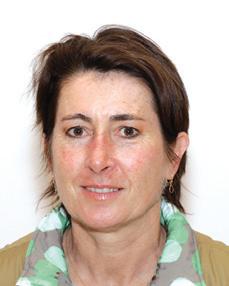
In the early 19th century, American whaling ships would anchor at Mosman Bay following their expeditions to southern waters. When visitors went onboard, they were given chowder, a dish favoured along the US Atlantic coast, made from boiling oysters, fish, salt pork and vegetables. The bay soon became known as Chowder Bay. A great way to explore the area is to walk here from the Taronga Zoo ferry wharf and then continue onto Balmoral Beach. Just don’t plan on lingering. As I laid out my picnic lunch, I drew the attention of curious onlookers as I was set upon by five kookaburras, eager to try my sandwich.
One of Sydney’s newest parks, Headland Park straddles the ridgeline along Middle Head Peninsula, once home to Borogegal aboriginals who had lived there for thousands of years, fishing in the bays and inlets. Fortifications with cannons and barracks were built along the escarpment in 1801 shortly before the Napoleonic Wars of 1803-15, to protect the colony from possible French attack. For two more centuries, the Defence Department occupied land at Middle Head, Georges Heights and Chowder Bay. In 1916, Australia’s third-largest military hospital was established at Georges Heights to care for wounded soldiers returning from the western front of Europe and in 1940, Middle Head became the home of HMAS Penguin, a naval base. During World War II a submarine net was placed across the harbour, with guns installed at Georges Head. Japanese midget submarines made it past these
The harbour foreshore on Sydney’s north shore is full of unspoilt bushland, secluded beaches and sweeping views

defences, entering the harbour in May 1942.
The bushland along this walk, ranging from coastal heath and scrubland to woodland and forest, provides a habitat for native wildlife including water dragons, blue-tongued lizards, ring-tailed possums, kookaburras, rainbow lorikeets, currawongs, herons and dollar birds. Signs such as ‘Caution possums’ dot the roadside, and encounters with animals are not uncommon.


The walk to Chowder Bay begins at Taronga Zoo, which is well deserving of a separate visit, and onto Bradley’s Head, one of the most scenic sections of bushland that Sydney has to offer, named after Lieutenant William Bradley who landed here in 1788. There are several historic sites to explore including Athol Hall, with a large wedding reception in progress on the day I visited, and the HMAS Sydney memorial mast, one of the most distinguished Royal Australian Navy warships of World War I, as a tribute to those who served.
The walk continues to Clifton Gardens, named after TH Cliffe, captain of one of the American whaling ships, past beautiful angophoras or Sydney red gums with their curved, twisted trunks, the bushland maintained by local volunteers. Two of the original members, the late Bradley sisters, developed the method of bush regeneration that is still used across Australia today. Around a headland, Clifton Gardens Park is an idyllic setting for picnics, with an adventure playground and protected beach with a netted enclosure ideal for swimming and snorkelling, enabling a view the abundant marine life.
Just beyond is Chowder Bay, a cluster of historic buildings built in the 1890s for the Submarine Miners’ Corps, now operating as cafes, restaurants, a dive shop with scuba gear and kayaks for


charming maritime village of historic buildings with an artist’s precinct and Frenchy’s café will greet you. The lookout provides a stunning vantage point with uninterrupted views across to Manly, Vaucluse and back to the city. Continuing along the bush track, a continuous line of metal stairs leads down to Balmoral, named after Balmoral Castle Aberdeenshire
The beachside promenade, esplanade, rotunda and Bather’s Pavilion, which date back to the 1930s, are heritage listed. The beach has splendid views to North Head and Clontarf
This is one of Sydney’s best urban walks, with vantage points overlooking the harbour and Pacific Ocean, well deserving of a visit.
One of Sydney’s newest parks, Headland Park straddles the ridgeline along Middle Head Peninsula, once home to Borogegal aboriginals who had lived there for thousands of years, fishing in the bays and
INF o
Taronga Zoo is a pleasant, if somewhat exhausting full day excursion, that children especially will thoroughly enjoy. Entry is expensive, with a 15% discount for families. Worthwhile considering is the annual Zoo Friends Membership that provides unlimited entry throughout the year. A guided behind the scenes tour with a zoo keeper is a worthwhile additional expense. Open every day, take the Sky Safari from the wharf up to the main entrance then follow the winding pathways back down. Children love entering the native animal enclosure to view wallabies, echidnas and koalas.
T: (02) 9969 2777 W: zoo.nsw.gov.au

The Sydney Harbour Federation Trust was established by the Australian Government to preserve Sydney’s maritime and defence heritage and offers tours, open days, programs for children and downloadable maps of walks.



T: (02) 8969 2100 W: www.harbourtrust.gov.au
INSIDER ’S TIP
Water dragons usually scamper off, but if they are slow to move, give them time, as they have sharp claws. Signage is generally good.

I did the walk in one bite size chunk. While the time given is two hours, allow time to amble along. The most pleasant way to begin is by ferry from Wharf 2 Circular Quay to Taronga Zoo returning from Balmoral by bus. Buses are fairly infrequent. Trip planner: T: 131500 W: www.131500.com.au
If coming by car, access is via Middle Head Road, Mosman.
WHERE To EAT
The area is well served by cafes and restaurants with more options in Balmoral or pack a picnic lunch.



as East Pakistan, has undergone one of its
most tumultuous years in its forty two year trials of Islamists accused of supporting the Pakistanis during the independence war, the country has since suffered the worst accident and has been Islamists demanding anti-blasphemy laws and
exposed to a bit more excitement than he had bargained for. He wrote in an email that “it’s truly an overstimulating time to be here”. He also suggested that it was high time Australia Minister had visited for close to fifteen years. Late last year, I was involved in a television story about shipbreaking in Bangladesh, the visually extraordinary industry that recycles the material of old ships to be used in everything wiring. Its slave labour, unsafe practices and light touch regulation bear much resemblance to the country’s garments industry so under the
I distinctly remember an image where a fleet whizzed by a dirt road, adjacent to a duck filled pond, where our crew shipbreakers bathing. Our fixer informed us that the motorcade
shipyard, they were engaged in crisis control after a worker was critically injured. The nexus of the military, politics and business was an
This shady but ubiquitous overlap is best recounted by former navy administrator Dr , which tackles the secretive ten billion dollar empire of Pakistan’s military leaders, ranging intertwined by a shared religion, history and identity partially built in opposition towards organising principle is religion and the other language, both represent an important front in the struggle for secular humanism amid religious extremism. Australia’s interest in both has been lukewarm at best, overshadowed by its wooing of rising economic behemoth

Australia is amongst the region’s highest aid donors, spending just under 100 million in both countries, representing the second highest donor as a representative of GDP.
fastest growing region supplying migrants to our country, as measured by the last Census, the historical neglect may require review.
Sinking deeper into the mire of financial dissolution, Europe still struggles to face up to obvious realities
unemployment and deepening frustration and anger, as witnessed by recurring demonstrations. Yet there is still a culture of denial.
BY NOEL G DE SOUZAEurope is in the throes of denial at several levels while seeking to perpetuate a self-generated myth that all is well on the European front. Broadly speaking, the denial is that its austerity measures are successful and are working well. Instead, we see demonstrations and endless rounds of citizens battling with police. The fact that in several European countries a majority of young people are unable to get gainful employment, is a stricture on the situation. There are no signs of the supposed recovery in the southern European fringe between Portugal and Greece.
Another form of denial is that the norms of the colonial era still apply. This implies that Europe fixes the rules which have to be accepted by all those countries that were once subjected to their diktats (including China, India and the USA.) For example, Europe has unilaterally imposed a carbon emissions tax on planes flying to Europe. Retaliatory measures are being considered by affected countries, including India and the US.

Regarding carbon emissions, the Indian Prime Minister, concerned at the slow pace of moves to stabilise global temperatures, has blamed rich nations for causing global warming in the first place.
This is best articulated by Christine Lagarde, head of the International Monetary Fund (IMF). She speaks as if the Eurozone’s problems are on the way to being solved and as if the austerity measures have been accepted by its suffering populations. Ms Lagarde has had a distinguished career, having held several ministerial posts in France, including for finance and agriculture. She is at the forefront in supporting the Euro and the Eurozone austerities.
Lagarde says that currently a ‘three-speed’ recovery is going on with Europe, and contradicts herself by saying that Europe is suffering from incomplete policies and lack of demand for its products.
The trouble is that European leaders have never faced a situation like the current one. Their problems have their source in countries like China and India, where industrialisation is moving fast and efficiently.
Austerity measures, imposed from outside on troubled countries by the European Central Bank, have led to massive unemployment and deepening frustration and anger, as witnessed by recurring demonstrations
Another denial is that European civilisation will help the EU to overcome its economic hurdles. This was stated by the current Spanish Prime Minister, Mariano Rajoy, when he assumed office. It implies that the specialness and superiority of European civilisation which was a pillar of colonialism. Since he made that statement, the Spanish economic situation has worsened with over half of its youth unemployed.
“The whole history of European Monetary Union is of lawlessness based on political convenience,” says Oliver Hartwich, a commentator for Bloomberg. He adds that the rules of the Maastricht Treaty on which the Euro was based were not applied to the Maastricht Treaty attending countries, even though their debt loads were higher than 60% of their GDP’s.
The European Union is in trouble and several countries within the Eurozone are groaning under high debt and rising unemployment. The Cyprus crisis starkly brought this out with moves to virtually confiscate a percentage of hard-earned savings and the imposition of other austerity measures. The rest of the EU hardly blinked, as if the problem did not concern them.
Austerity measures, imposed from outside on troubled countries by the European Central Bank, have led to massive
Compared to the negative growth rates in many Eurozone countries, the World Bank predicts growth of 7.8% in East Asian and Pacific countries, which is up from last year. Others are not as optimistic, but even with some slowing down, growth rates are still expected to be positive.
While Europe has been running down its infrastructure, China has been building spectacular cities like Shanghai and designing and running incredibly fast trains. India has been also been creating new cities and transport systems. Recently, the Indian government has asked its states to select areas to develop industrial zones along with new cities.
The fundamental reason why the European Union was formed seems to have got lost because of the Eurozone crisis. The EU was formed to end the countless wars which plagued Europe in the last two centuries. Neighbouring countries fought ruthlessly with each other and the result was a Europe ruined and exhausted. It was the American Marshall plan that helped to get Europe back on its feet.
The only plan which currently exists to bring economic order to Europe is the austerities plan for the Eurozone nations. Similar, though not identical austerities, are in the offing for Australia which is in a much better economic situation than Europe.
The European Union has had its reputation and its usefulness so tarnished, that an influential Tory group in Britain is talking of quitting the EU or at least renegotiating its terms of membership. These include Lord Lawson and former cabinet minister Michael Portillo.



Lawrence White is one of the leading monetary economists in the world, having made notable contributions to the theory and practice of free banking, central bank policy and economic history.
In an article written a few years ago, White complains about the United States Federal Reserve System, arguing that it is violating the law and exceeding its statutory authority under the Federal Reserve Act
“Central bankers today are discretionary rulers over the economy’s monetary and financial institutions,” writes White.

“Defenders of the rule of law, who in general decry the arbitrary rule of men, should specifically decry the rule of central bankers”.
For White, the American central bank’s unprecedented bailouts during the Global Financial Crisis should elicit outrage from across the political spectrum. The FRS has more than doubled its balance sheet, invested in assets that could expose taxpayers to large losses and has precipitated a significant increase in the monetary base that may lead to troublesome inflation.
Australians, meanwhile, have looked to their own Reserve Bank of Australia (RBA) with admiration rather than disgust,
and have even credited it with keeping Australia out of the economic panic that began in 2007. There is a strange indifference surrounding the question of whether the RBA adheres to the rule of law when it does things like fiddle with the cash rate or intervene in asset markets.
Perhaps it is time, however, to ask whether the RBA, like the FRS, could do better when it comes to acting consistently with the rule of law. Answering this question helps establish a red line in public policy debate. It says to anyone proposing a new idea using fancy economic reasoning that the idea must first pass the basic test of being compatible with the rule of law before being foisted upon Australians.
In 1873, Walter Bagehot wrote an intriguing book titled Lombard Street that explored the world of finance and banking and provided an eye-opening analysis of how financial crises should be managed. An important part of Bagehot’s contribution is the often quoted ‘Bagehot dictum,’ which states that in difficult economic times central banks should come to the rescue of firms facing a liquidity, as opposed to insolvency crisis. that is, central banks should save those firms that are otherwise solvent, but due to short-term factors have been placed in a tenuous position. And it should lend to them at a penalty rate.
Bagehot’s dictum is a rule of thumb that has been ignored by
central banks in the modern era. Central banks nowadays make politicised interventions in the marketplace, picking and choosing winners and losers without reference to a preannounced lender-of-last resort policy. It is this unchecked discretion in monetary policy that makes a mockery of the rule of law. The RBS began its central banking operations in 1960. Central banking is primarily about influencing the money supply, and consequently influencing the level of inflation and unemployment in the economy. To carry out its objectives, the RBA has a board that exercises discretionary control over short-term interest rates in the overnight money market, i.e. the market for loans between financial intermediaries.
This short-term interest rate then affects other interest rates throughout the economy.




Is the RBA acting consistently with the rule of law in targeting the overnight cash rate? If we interpret the rule of law as meaning adherence to a fixed Bagehot-style rule, then most certainly not, since there are few real checks on its meddling. Whereas, once central banks operated with reference to a gold standard that constrained their monetary interventions, the age of fiat paper money has significantly enhanced the RBA’s discretionary power to decide how much money to pump into the economy (bank officials retort that their inflation target of 2-3% limits their discretion, but holding it to
account is not as simple as it might initially seem given varying measures of underlying inflation).
A consequence of the absence of a monetary rule has been the creation of uncertainty among private actors. Market participants trying to factor RBA policy into their business plans are faced with a daunting task in the absence of an easily ascertainable method of predicting which way the winds will shift the cash rate any given month. This state of affairs is the essence of the ‘rule of men,’ where observers hang onto the words of a group of bureaucrats, and is the antithesis of the ‘rule of law,’ where stable guidelines of general application are promulgated.






has not yet been able to express his feelings. He wants to give her all the happiness in the world.
bakwaas, time-pass or sheer escapism, Bollywood has an inexplicable influence on our lives. We laugh at films like Golmaal , and are profoundly stirred by films such
Taare Zameen
Zindagi Na Milegi Dobara
We imitate the fashions, travel the same spots, and adopt the wooing or dancing styles of the stars. We have our favourites or pet loves, and often life-long single-sided internal love affairs with some of the most glamorous stars. And don’t deny it, most of us have our own Bollywood fillum that we have come up with, inside our heads!
As a homage to the centenary of the Hindi film industry, I came up with an idea to develop a Bollywood film on air, with contributions from the listeners. In a concept created along with Neelam Vasudevan, Indian Link Radio’s Program Director, we set up a backdrop, and then gave the
Simran is a simple girl who, like every girl, wants to be loved. However she is attracted towards the caring nature of Raj and has a special place in her heart for Raj.
Raj is a simple-living-highthinking type of person with strong values and beliefs. He’s a great guy with a charming personality. He too has a soft spot for Simran.


Sameer Mehrotra: Vijay gets into gambling to make fast money and even spends his university fees to fund his habit. As fate would have it, Vijay loses his money and gets into heavy debt. Raj and Simran don’t know this reality. They think Vijay is doing well financially and are proud of him.
Harmeet Hora: One fine evening all three party it out at shimmering Darling Harbour. Over drinks at the nightclub, Simran spills her wish to live the luxurious life one day, to be able to travel first class and to exotic locations. After a few drinks down Vijay in his emotional outburst shows his inclination towards Simran but she is not able to identify.
However Raj understands it all
Harmeet Hora: Vijay books two business class tickets and a holiday package at a grand resort in Singapore to show Simran a good time. He uses the advance money given to him by the baddies. He plans to smuggle the drugs packet through Simran’s hand baggage as he assumes it would be easier for her to get through security.

Harmeet Hora & Sagar
Mehrotra: As luck would have it, Simran is caught at customs and is put behind bars. This came as a jolt for Vijay as this was not the part of the plan! The baddies are waiting around menacingly to get their shipment. Vijay is devastated and at this moment he realises what he has lost. He has lost his love and the trust of a good friend, as well as respect and money. He is financially and emotionally broke! He discloses everything to Raj. Raj explains to him that there is no shortcut to success and asks him to surrender himself to police.
Climax by Harmeet and Sagar
Raj and Vijay are on their way to police station. But they are confronted by the bad guys to who
However Raj sees him doing that. He is devastated that his friend is involved in illegal activities and using Simran; he thought Vijay loved Simran!
Punita Udeshi: Raj acts fast and cleverly records everything on his smartphone. When Simran is caught red handed, Raj comes in for her rescue and reveals the truth. Vijay is held by the cops. Simran comes to know the actual Vijay. Raj and Simran live happily ever after...
The story line all settled, we called for on-air auditions for our lead roles. Caller Shreeram auditioned successfully for the role of Vijay; caller Prabhjot for the role of Raj, and caller Rashmi for the role of Rashmi.
In a special cameo, caller Gopal impressed with his audition for the role of Simran’s father (presented in Paresh Rawal style)!
There were contributions by our listeners through Indian Link Radio Facebook page and phone at various stages during the story was built as below:
Janaki Bhatia: Vijay ko cancer ho jata hai, first stage. Raj comes to know, but not Simran.

Manu Puri: Classic tale of Dostana-style love i.e. Vijay is falling for Simran, Simran for Raj, but Raj is falling for Vijay. A sure film in 200 crore business club!
statement, police is able to crack a big drug racket. All charges against Simran to the airport. Vijay plants
Prabhjot Virk: Raj has passports of both Vijay ands Simran as he escorts them to airport. He sights Vijay planting drugs in Simran’s handbag.
Instead of confronting, he says “Guys, I am sorry, I’ve forgotten your passports at home”. That cancels their trip and Simran is saved.
Produced by Indian Link Radio Concept: Neelam Vasudevan
Directed and Narrated by

As a homage to the centenary of the Hindi film industry, I came up with an idea to develop a Bollywood film on air, with contributions from the listeners
There’s no way I can give Simran the life she wants, he feels, and so decides to sacrifice his love for Simran
Leading Food Distribution Company

Required a well-spoken, mannered person who is willing to build a reputation with his/ her customers. Based on honesty, a person who has communication knowledge which will help promote the Company goods and bring new customers.

Own car is required. This position is a full time position which caters from 9am-5pm. Must know the Urdu Language.
If you are interested please forward your resume to linda@nimco.com.au or n.elmagchouch@nimco.com.au
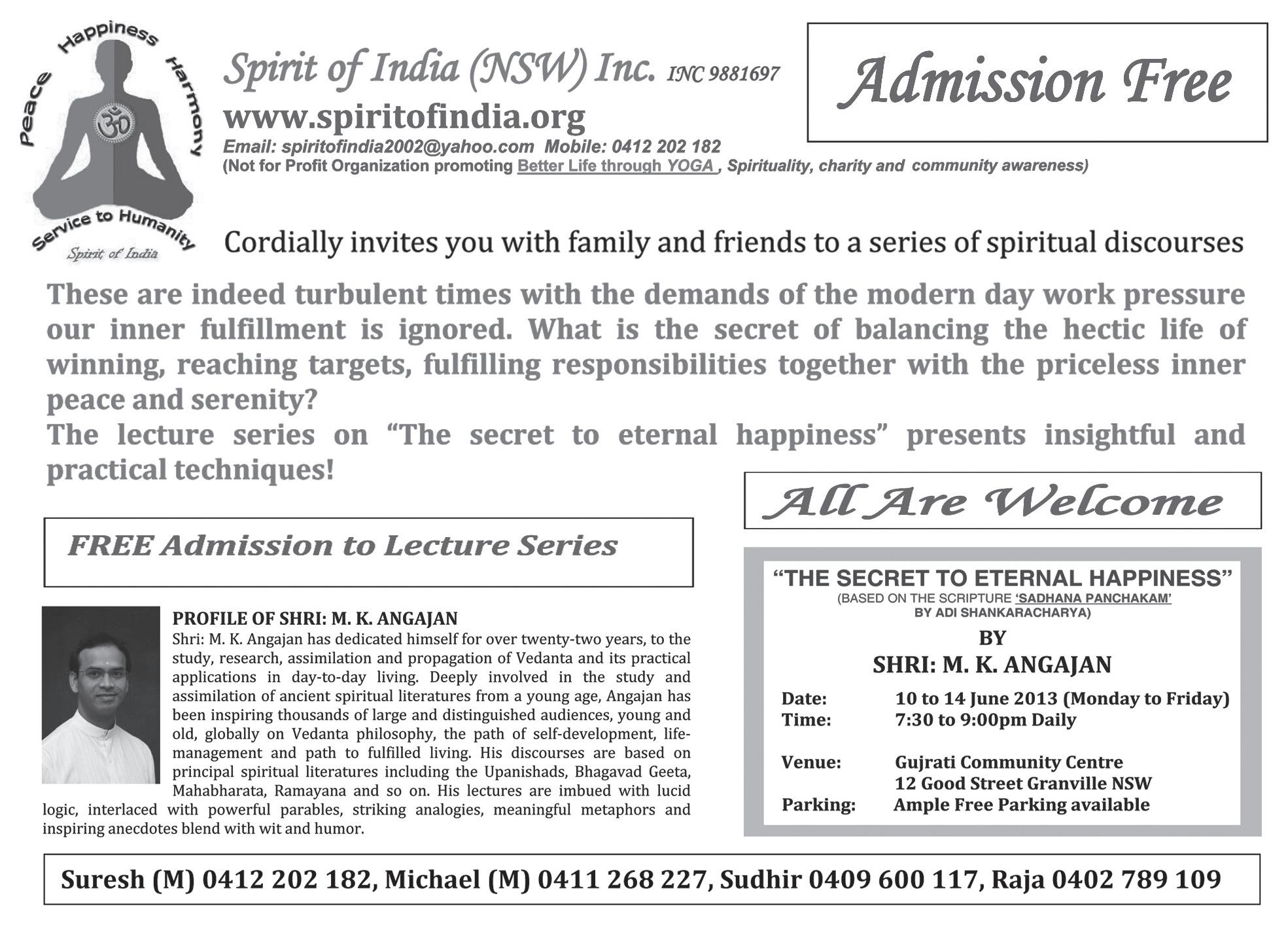






Edging the shores of the turquoise blue Bosphorus
The first thing I did after arriving in Istanbul was to throw up my arms in despair, simply because I could not decide on what to miss out on from the wide range of attractions that the magical city has on its menu. However, the concierge at the Crown Plaza Hotel came to my rescue, providing a top-ten itinerary that is ‘inescapable’ for first time visitors to the land, like me. Istanbul is often touted in guidebooks as the ‘Turkish mystique par excellence’.
Founded by the Greeks in the 5th century BC as Byzantium, renamed Constantinople 800 years later by Roman Emperor Constantine, and finally called Istanbul by the 15th century Ottoman Sultans, this historic settlement uniquely stands astride two continents, Asia and Europe. It boasts to be the only metropolis that has served as the capital of two consecutive Christian and Islamic empires, a distinctive position that crafted the region’s history for over 2500 years.
Sea with a majestic skyline dominated by palace domes, mosque minarets, church spires and regal monuments, Istanbul is reputed to strike anyone as a domain where natural beauty has been enhanced by human endeavour, bequeathing the land with an ensemble of marvels which can’t be covered in one visit. However, a reasonable impression can be achieved by visiting the ‘top ten’ listed below.
1. Blue Mosque
What the Eiffel Tower is to Paris, or Big Ben to London, the Blue Mosque is to Istanbul. Built in 1650 it is by far the most famous landmark of Istanbul. The exterior of this 400 year old shrine doesn’t have a pinch of blue in it at all, as the name comes from its 20,000 odd hand-made ceramic blue tiles that gracefully decorate the interior. With six minarets and eight domes, it stands within a spacious courtyard as a great sample of Islamic architecture from the classical period.
2. Süleymaniye Mosque

Istanbul can be easily termed as the ‘City of Mosques’ as you can see one in almost every corner. All of them are architecturally
Timpressive and demand notice, however apart from Blue Mosque, the other one on most visitors’ itineraries is the Süleymaniye Mosque. It is the city’s largest, and is considered as the greatest achievement of famous 16th century Ottoman architect Mimar Sinan.
3. Topkapi Palace

The residence of the Ottoman Sultans for 400 years, Topkapi Palace is not a single edifice, but a band of many. Similar to the Forbidden Palace in Beijing, dotted across an expansive garden-courtyard. Many of the ancient buildings have been restored and converted to museums that display Ottoman memorabilia, from their precious jewels and royal clothing, to sturdy swords that have beheaded their challengers. However, the most interesting in the precinct is the harem quarter where the Sultan’s numerous wives and mistresses used to live.
4. Dolmabahce Palace
When Topkapi Palace was abandoned in the mid 19th
century, Dolmabahce Palace became the royal quarter. Edged on the Bosphorus with a 600m waterside frontage, this grand white edifice impresses visitors by its excessive display of ostentatious wealth. One good example is a 4000 kg chandelier with 750 bulbs, one of the largest ever made, which adorns the hugely ornate throne room.
If you have time to see only one thing in Istanbul, it has to be the Hagia Sophia, the legendary legacy of the Christian Byzantian Empire. Originally built as a
church, it was later converted to a mosque by the Islamic Ottomans. For almost a millennium it boasted to be the largest enclosed space in the world, designed lavishly to show locals and foreigners the strength and wealth of the Turkish emperors. The stunning inside mosaic artwork testifies to that claim. Since 1934, this iconic sanctuary has been open to the public as a museum.
6. Grand Bazaar


You can feel the pulse of Istanbul when
visiting the mystic Grand Bazaar, which is said to be the largest covered market in the world. There are around four thousand shops selling an array of merchandise from cheap souvenirs, homeware and delicious Turkish delights, to expensive handbags, carpets, shawls, scarves and shoes. It is a paradise for shopaholics. Also worth visiting is the nearby Spice Bazaar which has been the city’s premier spice outlet for several centuries.
7. Bosphorus cruise

Cruising in the Bosphorus Strait, which separates Europe and Asia, gives visitors the opportunity to see a silhouette of
Istanbul from another perspective. Taking the cruise makes it possible to visit the suburb of Uskudar which lies on the Asian side, and offers far more Middle Eastern flavours than its European counterpart.
8. Galata Tower
The 1349-built, 61-metre high monument dominating the city’s skyline finds a place in this list because from the viewing gallery of this circular tower, one gets the best 360 degree panoramic view of Istanbul.
9. Istiklal Street
This is the city’s liveliest thoroughfare through which thousands trundle every day. The only vehicular movement breaking the flood of human activity is the slow passage of nostalgic wooden trams, which sometime stop service if the crowd is too thick to penetrate. Both sides of the street are lined with elite shops selling high-class accessories and jewellery, art galleries, cafes where discussions are vibrant, and passages dotted with drinking joints. Most of the buildings surfaced here at the turn of the 20th century under the influence of the art nouveau movement.
10. Cagaloglu Hamami

Without a traditional Turkish bath at a public bathhouse, a visit to Istanbul is incomplete. There are almost hundreds to choose from, but the best place to take a watery plunge is the Cagaloglu Hamami built in 1741. Here many renowned personages from King Edward VIII and Florence Nightingale, to John Travolta and Cameron Diaz have experienced the traditional practice. It is so famous and popular that American author Patricia Schultz’s has listed it in her popular book 1000 places to see before you die. The hour long exercise generally comprises of a steam bath, body massage, followed by a splash with bucket-loads of water, soap and shampoo, to bring a clean and happy ending to the ritual.
Main pic: Illuminated Blue Mosque

Top right: Topkapi Place Complex
Inside Hagia Sophia

I STANBUL GETTING THERE
Singapore Airlines (www.singaporeair.com) flies from major Australian cities to Istanbul via Singapore.

ACCo MM o DATI o N
Istanbul has no shortage of hotels to suit your budget. The Crown Plaza (www.crowneplazaistanbul.com) in the Old City is one option. Otherwise see www.expedia.com.au or www.booking.com for best deals available Cagaloglu Hamami: See www.cagalogluhamami.com.tr for address and pricing
Below from left to right; Bread making Galata Tower
Dolmabahce Palace Garden
Grand Bazaar
Delicious Turkish delights
Suleymaniye Mosque interior
View of the Istanbul skyline



What I am suggesting will upset wives, anger husbands and infuriate parents. It may even shake the very foundation of marriage. But it is time to amend laws in order to protect the assets of the ones who built them.
I am talking about ‘inheritances’ and the transfer of these. History is being made every day with daughters-in-law demanding payment for producing the grandchildren of the family and by sons-in-law who are forcing their wives into litigation so that they can grab a share of their in-law’s wealth.
I am Kiran Shah, billionaire shipping magnate and entrepreneur. I am ranked as the fifth richest man in the Asian Pacific region, and I began my career dismantling large ships, but I earned my wealth by building aircrafts.
From being forced to watch my wife put in 14 hour days looking after the administrative details, while nursing a child, I was finally in a position to see her enjoy a life of luxury. And I took my precious family from a modest two bedroom unit, to a seven storey waterfront home. No one remembers the struggles we had in the past, yet all speak of our new unparalleled wealth.
But wealth serves two purposes in life. It is either a passport to heaven or an invitation to hell. How we make our money and how we spend it, determines its purpose. Wealth also attracts two types of people. Those who are genuinely happy for you and those who feel they have a right to it. And the easiest way to grab a share, is by marriage.
Last week had my wife and I separated, she would have had the right to half of our entire estate because we built it together. Even though she was just looking after our kids, she was contributing to our progress and prosperity. Whatever we owned, was jointly earned.
My children married under different circumstances. They were already managing directors in the company and earning a substantial salary. When they became twenty-one we gave them
their independence. When they married we gave them the keys to a furnished home.
Ours was a happy home, a successful venture and a prosperous dynasty. Like every such platform we too faced the next phase of success – the inevitable discord within the family over money. The year after we saw the last of our children married, we lost our eldest son in a car crash. Still recovering from the tragedy, we were given a greater shock by his wife, who we had treated as a daughter. She claimed that my son had willed the ‘expected share’ of my property to her and her daughters. Fearing that she would be unable to defend their children’s rights without her husband, she was filing for separation of assets.
Not to be outdone, my second daughter-in-law filed for divorce. Along with it she filed a criminal case against my wife, citing abuse, misuse of trust and withholding of her dowry, the usual charges most daughters-in-law now use on the commencement of divorces. Dowry? Every item she owned was given to her by us. She was an orphan child brought up by her maternal uncle who had made it clear that financially he was not in a position to do anything for his niece. My son was so in love with her that we were more than happy to bear the entire cost of the wedding and clothing. Little did we know that our generosity would plant the first seeds of greed and would one day teach her to love it more than loving our son.

Seeing the daughters-in-law trying to grab their share, our
son-in-law too armed himself with legal documents demanding his wife’s share. And what did his wife do? She killed the daughter that we had so lovingly brought up.
After they left, my wife and I debated the right course of action. Surely the correct thing to do would be to give them what we were going to leave for them anyway? Surely every child has earned the right to their parent’s property? Finally we came to the conclusion that life would be easier and more peaceful if we agreed to their demands. Prepared to sign things over, we set the date for a joint meeting and the distribution of assets.
A week before the meeting, my lawyer revealed the details of one of their documents. The next generation had been planning to declare me insane in order to take over control of the assets – the assets that my wife and I had accumulated.
My wife, using her maternal instincts, requested that they be forgiven. I used my paternal wisdom and decided to punish. I tore up the deeds that had been prepared and I demanded new documents. If my wife was surprised by my action, my lawyer was flabbergasted. My mind had been made up, and it was not going to be altered for anyone.
On the evening that the family gathered together, my lawyer handed out the sealed envelopes to each of them. I could see surprise and greed on their faces, and like dogs they pounced on the envelopes at my nod. As anticipated, they each threw down their documents on
the table and stood up.
My son asked disbelievingly “Is this a joke, Papa?”
“Since when do insane people joke?” I queried softly, noting the shock on their faces. Not giving them time to respond I continued “If I was you, I would pay those documents the respect they deserve. None of you are worthy of it, but it is being given because that is our duty. It is equal and fair. Your mother and I each have the same amount as well”.
“But we have a million time more,” came my eldest granddaughter’s comment.
And so the pack was hunting together. In a home where only wealth is worshipped, even the children will make it their God.
“No little one, you don’t have a million times more. Your grandmother and I did,” I replied.
“Did! What do you mean did?” my daughter jumped in, echoing her husband’s manner.
“Sit down everyone, for your mother and I have some generous news”. As soon as they were seated, I continued, “To atone for my sin in failing to imbibe the right qualities in our children. For failing to teach the traditions to our in-laws and for not educating our daughter and grandchildren in proper etiquette, my wife and I have donated everything else that was owned by us, to your favourite charities. We stand before you, equal in wealth and equal in emotion. We have nothing more to give you all for we own nothing else. And we want nothing from you all, for you have nothing to give. It is a good situation to be in. Finally a true equality!”
The easiest way to grab a share, is by marriage
We knew what our next move would be, to fight for pre-nuptial agreements to be made mandatory

It led to a bitter battle, and when they left we had sacrificed our kids and extinguished our love.
We knew what our next move would be, to fight for prenuptial agreements to be made mandatory. It is the only way we parents can protect the rights of our kids. The only way our hard earned wealth can be left to us. Only ‘our children’ have the right to ‘inherit our’ property. What we give to their partners and our grandchildren must only be gifts. On our death, our estates should only be shared by those for who we struggled and for who we dreamed. Our children’s partners can look to their own parent to sue or abuse. This must become law. And this must be done now.

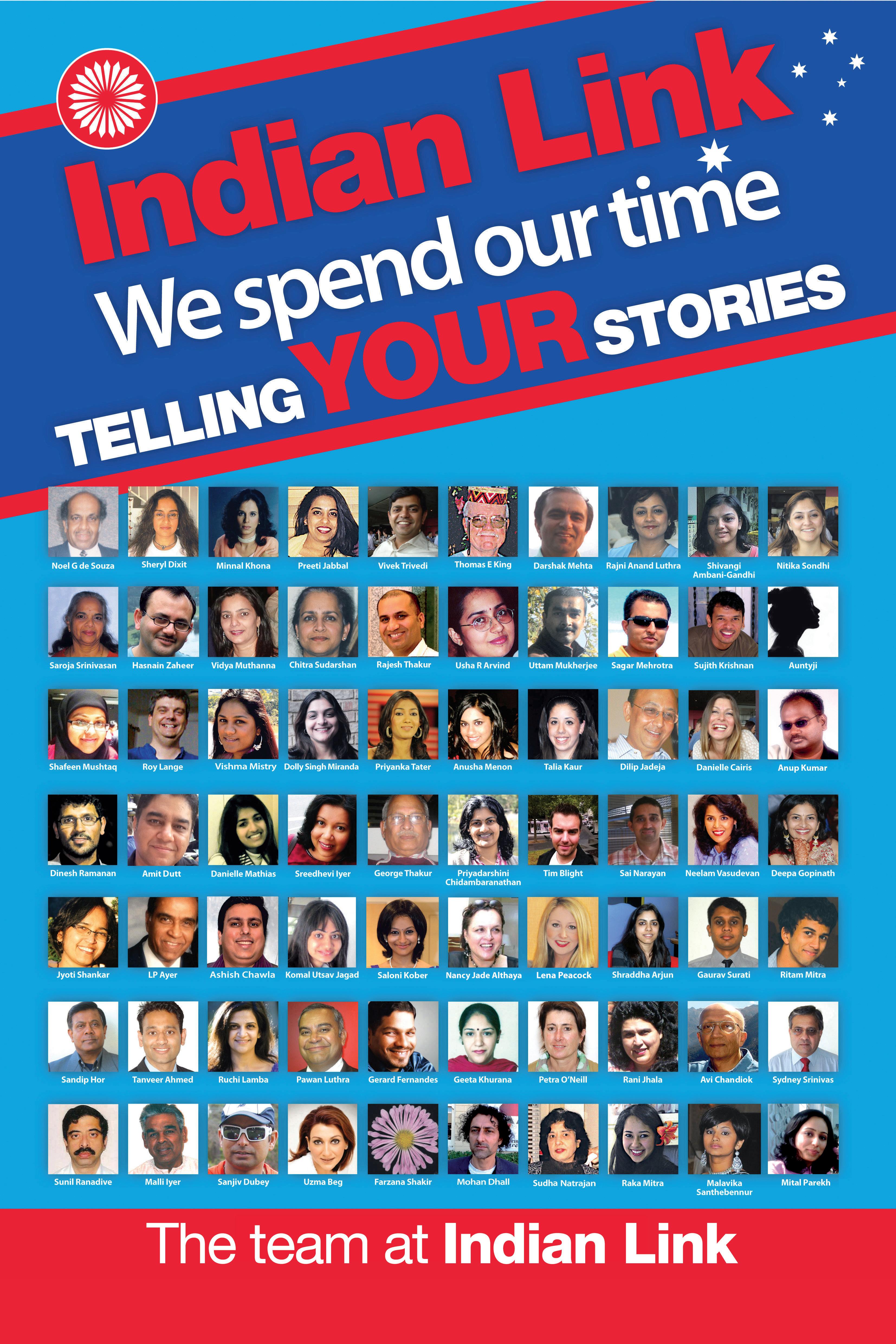


Fat free and low in kilojoules, this sweet fruit has more than twice the recommended daily requirement of vitamin C
Did you know that there are two types of papaya?
Red and yellow. Well, now you do. One isn’t just a little bit more ripe than the other. And how do you tell which is which? Well, it’s simple. Red papaya is the sweet, pear shaped one, with orange-red flesh and a yellow-orange coloured skin, whereas the yellow variety is a bit bigger and rounder, with yellow flesh and pale orange skin. And right now in May (and then again in September and October) is their peak season.
And how to tell when they’re ripe? They’re a bit like avocados or pears, they’ll yield to pressure around the stem. And remember, you’ll have to be extremely careful with them to avoid bruising. Store them in the fridge if you aren’t going to eat immediately.
“Red papaya and yellow papaya are perfect ingredients in a variety of recipes,” MasterChef Series
Two contestant, Alvin Quah says. “Their sweet tropical flesh works beautifully in desserts and cakes, but they’re equally lovely in savoury dishes. They add colour and flavour to fresh salads and, due to an enzyme they contain, they can be used to tenderise meats such as chicken and pork”.
Fat free and low in kilojoules, papayas contain a wide variety of vitamins and minerals. Just 150g provides more than twice the recommended daily requirement of vitamin C, as well as vitamin A, calcium, iron, carbohydrates and a wealth of protective antioxidant carotenoids. Now that’s a whole lot of goodness!
Lemongrass chicken with papaya and cucumber salad
Serves 4
Prep: 15 mins
Cooking: 10 mins
Ingredients
4 (about 150g each) chicken breast fillets
1 stem lemongrass, pale section only, finely chopped
2 tsps peanut oil
1 tbsp fresh lime juice
2 tsps fish sauce
2 tsps brown or palm sugar
½ tsp sesame oil
1/2 papaya, deseeded, peeled, very
thinly sliced
2 Lebanese cucumbers, end trimmed, thinly sliced lengthways into ribbons
½ cup round mint leaves
½ cup Thai basil leaves
1/3 cup toasted peanuts, coarsely chopped
Steamed Jasmine rice, to serve

Method
1. Preheat oven to 180°C. Place the chicken and lemon grass in a large bowl.
Drizzle with oil and gently toss to combine. Season with salt and pepper.
2. Heat a large frying pan over medium-high heat. Cook chicken for 2 mins each side or until golden. Transfer to an oven tray and bake for 8 mins or until just cooked through. Remove from heat and set aside for 5 mins to rest.
3. Meanwhile, combine the lime juice, fish sauce, sugar and sesame oil in a small bowl. Place the papaya, cucumber, mint and basil in a large bowl. Drizzle with dressing and gently toss to combine. Divide evenly among serving plates.
4. Thickly slice chicken and place on serving plates. Sprinkle with peanuts and serve immediately, with steamed rice, if desired.
Tips: For a summery change, use salmon fillets or tuna steaks instead of the chicken. Cook salmon or tuna on a chargrill, 2-3 minutes each side for salmon; 1 minute each side for tuna.

Serves 4
Prep: 15 mins
Cooking: 5 mins
Ingredients
2 bunches asparagus, woody ends trimmed, diagonally sliced into 5cm lengths
2 baby fennel, ends trimmed, fronds reserved
½ papaya, deseeded, peeled, thinly sliced
100g baby rocket leaves
2 x 125g portions hot smoked
salmon, coarsely flaked
1 lemon, zested, juiced
¼ cup (60ml) olive oil
2 tsps Dijon mustard
2 tbsps finely chopped chives
Method
1. Cook asparagus in a large saucepan of salted boiling water for 2 mins or until bright green and tender crisp. Refresh under cold running water. Drain well. Place in a large bowl.
2. Use a vegetable peeler or mandolin to thinly slice fennel lengthways. Add to asparagus with papaya, rocket, salmon and lemon zest.
3. Combine lemon juice, oil, mustard and chives in a screwtop jar and shake until well combined. Taste and season with salt and pepper. Drizzle over papaya mixture and gently toss to combine. Divide among serving plates and sprinkle with reserved fennel fronds. Serve immediately.
Tip: The hot smoked salmon can easily be replaced with barbecued fresh salmon or chicken breast fillets.

Serves 6-8
Prep: 15 mins
Cooking: 1 hr
Ingredients
2 cups (300g) self-raising flour
1 cup (200g) brown sugar
1 tsp baking powder
½ cup (125ml) mashed papaya
½ cup (125ml) mashed banana
2 eggs, lightly whisked
150g butter, melted, cooled
½ cup (70g) toasted macadamias, coarsely chopped
½ cup finely chopped papaya
Honeycomb butter: 100g butter, softened
30g honeycomb, coarsely chopped
Method
1. Preheat oven to 180°C. Grease and line the base and sides of a 8 x 24cm (base measurement) loaf pan.
2. Combine the flour, sugar and baking powder in a large bowl.
3. Combine mashed papaya, banana and eggs in a small bowl. Add to the flour mixture with the melted butter, macadamias and extra papaya and gently stir until just combined. Spoon into the prepared pan and smooth the surface with the back of a spoon. Place on an oven tray and bake for 1 hour or until a skewer inserted in the centre comes out clean.
10 mins before turning onto a wire rack to cool.
4. Meanwhile, to make honeycomb butter, use an electric mixer to beat butter until pale. Add honeycomb and stir to combine.
and dollop with honeycomb butter. Serve warm or at room temperature.
Recipes courtesy of: Sarah Hobbs www.australianpapaya.com.au
attention: l adies and Gentlemen
What Would You Do If You Were Given A Once In A Lifetime Opportunity To Get Involved In An Exciting Business . . . BEFORE Anyone Else Even Knew About It?
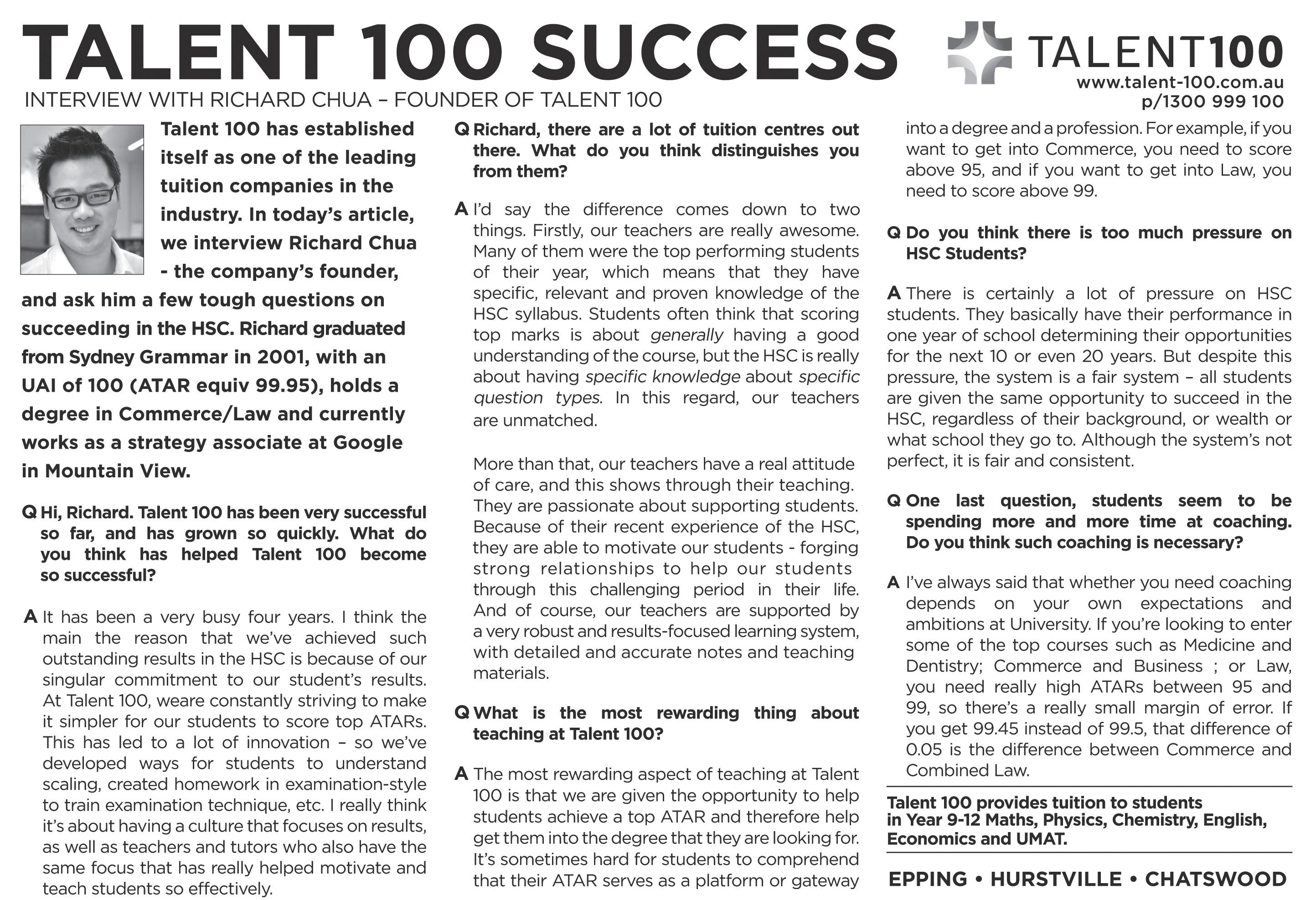
A multi – million $US Company is set to launch a Healthy Coffee and Tea in Australia and New Zealand in the next 4-6 weeks. There are 27 million cups of coffee drunk in Australia every single day. That’s 10 Billion cups per year. Want a piece of that business?
To learn how you can position yourself prior to the launch simply call (02) 8072 6266 noW for more information. $10,000 per month possible in just 6 months.
With 37 years of experience inherited through family with reputation of helping people all over the world. therefore I strongly believe that I can solve your problems in the quickest way. Are you suffering from influence, blockage, unknown diseases or unhappy situations that you cannot get out of it. If so, then do not hesitate to contact me Mr Habib who can solve all of your problems within 7 nights especially Sexual problems, or Bad luck Business matters, exams, Court cases, Unhappy marriages or Relationship problem and many more.

100% guaranteed service work. By correspondence also available. Call now on 0413 796 391 or 0470 641 395.




Well settled parents looking for suitable match for their 32-year-old daughter, who works for a multinational company in Sydney in a senior corporate position. Pretty, beautiful, 163cm tall, brought up in, and values both Indian and western culture. Seeking Hindu professional man, preferably from a well settled family background. Please contact: sur6958@gmail.com or mobile: 0404 147 744.
Seeking suitable match (from Australia, never married) for Hindu girl 35 years old, chartered accountant (non-veg), living in Australia over 25 years, with eastern and western family values. Please email: ganesh2011v@gmail.com
Match wanted for 42-year-old highly established, tall, slim, very pretty and smart doctor. Looks around 20-25 years of age and belongs to a highly educated and affluent family. Divorcee but marriage was nonconsummated. Please contact: ladoctoroz@gmail.com
Well settled parents looking for suitable match for their 30-year-old daughter working as a clinical psychologist in Sydney hospital. Pretty, beautiful 165cm tall, brought up in and values both Indian and western culture. Hindu professional man from well settled family background
preferred. Please contact: fame46213@gmail.com or: 0452 227 920.
Suitable match for beautiful slim, Jjatt Sikh. Born on 22th October, 1987. Height: 5’, 3”. Graduated from P.U Chandigarh. Is in final year of studying interior design. Belongs to well settled family. Living in Mohali. Looking for a clean shaven, permanent resident/ citizen of Australia. Please contact: ravinder_perry2007@yahoo.com.au
or: 0434 331 143 (Australia)
or + 91 987 201 0496 (India).

Respectable Punjabi Khatri family of New Delhi seeks alliance for their smart good looking sweet natured family oriented dentist daughter pursuing M.D.S(Pedo) 28/159cms, looking for a boy from a cultured family well settled in same profession. Email: drsobti1984@gmail.com

Seeking groom for Hindu Punjabi 30-yearsold, 5’1”, Australian citizen, well qualified, fair, charming, family oriented, responsible girl in Sydney. Brought up in India. Well settled, qualified, professional suitable matrimony match required. Caste no bar. Previous marriage annulled. Contact: +614 062 82 784 or: Lifepartner145@yahoo.com.au
Suitable qualified match for beautiful Ramgharia Sikh girl 32-years-old, 5-3’ divorced after brief marriage, issueless. Aus citizen. MBA (HR-Commerce) presently working in good
position at bank in Sydney. God fearing and cultured family. Girl’s parents visiting Australia in June. Local phone: 0412 254 015 or ranveer.singh787@gmail.com
Suitable well-settled/ professional match for Punjabi Arora beautiful never married 39/ 166 qualified IT professional. GSOH with good family values. Brought up in India. Working in MNC Sydney. Australian citizen. Early marriage. Serious enquiries only. Email details with photo ausgirl101@gmail.com
Seeking bride for a 27-year-old well settled Catholic gentlemen 5’6”, permanent resident, studied Electronics Engineering and working in a steady job as a technology officer earning a good salary. Living in Canberra. Please email: catholic_guy_1985@outlook.com
I am a 50-year-old Hindu , 5’4’’, Australian citizen, never married, and issueless. I am looking for a lady to share life with. Contact Arun: arun9tiku@yahoo.com.au or 0470 626 483.
Bangalorean gentleman 43-years-old, born in Coorg, India. Sincere / God fearing. Alliance for genuine girlfriend aged 27-45 yrs, possibly early marriage, student, tourist, PR ladies interested. Please call Mr Davha for appointment on: 02 9676 2512 or: 0458 153 193.
Seeking match for highly educated, nevermarried, 5’ 9”, 1975 born Sikh Khatri boy. Full-time permanent job with decent income in customer service role. Looking for well-educated, never married Sikh girl from Australia. Early marriage. Phone: 0422 102 242 or email: jas_ghai01@hotmail.com


She may have topped the list of Times 50 Most Desirable Women of 2012, but Bollywood actress Deepika is embarrassed by compliments. The actress claims that she is not good at fielding compliments and adds that beauty and physical attributes are ‘artificial’.
“It is a bit embarrassing. I mean, I don’t know how to take compliments! I don’t know how to react! It must be a good thing,” said the 27-year-old recently.
Deepika prefers people to appreciate her personality traits and not just her looks saying, “I have always said that people should find me desirable for the person I am - whatever little they know [about] me through my interviews and interactions. I hope it doesn’t have much to do with beauty and physical attributes because that, for me, is all artificial. They are superficial things”.
Deepika has been a part of the film industry since 2006, and has hit films like Om Shanti Om, Cocktail, Love Aaj Kal and Housefull under her belt. She also has Ayan Mukerji’s Yeh Jawaani Hai Deewani and Rohit Shetty’s Chennai Express in the pipeline, and is likely to carry away compliments for these. So get used to it Deepika, because people like you for who you are!
Soha is no Sharmila
She may be the product of a famous family, but Soha Ali Khan insists that she is her own person, not a clone of her famous mother, veteran actress Sharmila Tagore.
We love you Vidya Balan, but did you make us cringe at Cannes!
Surely you, the most cerebral of Bollywood’s women, should have known better.
The demure chunni over the head, when you’re supposed to be holding your head high? An outlandish lehnga that makes you look positively medieval? What were you thinking?
And Big B - who advised you on that ridiculous street-band-wallah outfit, when all your contemporaries were dressed in smart jackets? And those white shoes with navy trims, were they left-overs from the sets of The Great Gatsby?

Sonam Kapoor, you made our eyes pop out with that absurd nose thing, and we had to look closely at
your outfit to make sense of what it was: sari with a jacket that trails on the carpet? Other than that, your look can best be described as a make-up malfunction: it was as if the photographer caught you mid-way through your make-up for a traditional dance recital.
Overall, you looked quite the nautanki at Cannes this year, Bollywood. Literally. It was like you were dressed for a fancy dress party. National dress and all that is understandable, but this is preposterous.



This might be a bit harsh, but if you’re craving broader recognition at the international stage, Bollywood, it’s going to take longer for them to warm to you if you insist on appearing so insular.
“Why would I want to do my mother’s film remake,” asks Soha in perturbation. “That would be like suicide for me because I am inviting people to compare me to her. Rarely people will make favourable comment. The idea is to do something new and fresh. If it’s a contemporary adaptation then it’s okay”.
Soha says that she isn’t in filmdom for either fame or money, but she wants to do good work. She doesn’t have too many hits to her credit, but then, she is not ‘commercially focused’.
“My motivation is not how much my film will make. My motivation is, will I enjoy working in it? I am not interested in making a lot of money. I am fortunate to have financial security and that’s [money] never been a motivation factor for me,” she explains.
Soha has tried her hand at acting too, starring in films like Rang de Basanti and Khoya Khoya Chand, but hasn’t had the runaway success like big brother Saif. However, this doesn’t seem to bother her either. “I am not even interested in being famous. I think being famous has a lot of stress. It’s very stressful being an actress. Actually, being an actor is very complicated. You have to be almost superhuman to deal with everything. It comes with a lot of baggage,” she says candidly.
But the one thing that is evidently special to Soha is her mother, whom she describes as a ‘good homemaker’.
“I take a lot of tips from my mum on how to be a good homemaker,” says Soha, who has been dating actor Kunal Khemu for a while now.
“She was a very good wife and a good mother and she does give me advice. One of the things that she said was - a man must never hurt a woman’s emotion and a woman must never hurt a man’s ego; and if you respect the man’s ego and the man respects the woman’s emotion, then you will be okay,” she states. Mum always knows best, Soha!
Fortunately for this young lady, people have now stopped comparing Soha to Sharmila. “Sometimes when I dress in a particular way, people say I look like my mom. Even if you are comparing favourably or unfavourably with my mother, I am not competing with her, I am competing with my fears,” concludes Soha on a somewhat confusing note.
But there’s no doubt that Sharmila’s daughter with her striking personality and independence, is a chip off the old block! ranbir in real-time
While Ranbir carries on the Kapoor tradition of acting in Bollywood, he’s not completely averse to a stint behind the camera.
“I would like spend the next 15 to 20 years of my life on film sets,” said the 30-year-old actor. “I hope I keep on getting opportunities to work with good directors. That is my plan, but whenever we make plans, God laughs at us”.
“I want to make movies too. That’s something I would love to do - direct a movie,” added Ranbir at a promotional event recently for his forthcoming film Yeh Jawaani Hai Deewani, which is directed by Ayan Mukerji and also features Deepika Padukone.
On the subject of the actress, Ranbir admits that Deepika is the only one in the industry who intimidates him. “I always expected from Deepika to reach very high levels, but I had no idea that she will become such a fine actress so soon. She is the first actress in front of whom I am a bit intimidated,” said Ranbir, who will appear

on screen with her after a gap of five years, since Bachna Ae Haseeno in 2008. And that’s a surprising statement coming from Ranbir who has wowed the audience with a variety of roles in hit movies like Wake Up Sid, Raajneeti, Rockstar and Barfi!
Talking about Deepika’s growth in the industry, Ranbir said, “I felt like she was not doing what I expected her to do. That constant surprise was a good feeling. I know her so well. I know her advantages as well as disadvantages. She has turned her disadvantages into advantages. So, I am very happy for her.” Well, he would know the actress a bit better than most, as they were a real life ex-couple a few years ago.


Most celebrities are hounded by rumours and Ranbir accepts it as part of an actor’s life. “I can understand there is a demand for this. People want to know all about their favourite actors and actresses,” he claimed. “But when it comes to you, you feel bad. But you have to focus on your work. Because when on a Friday your film releases, everyone forgets everything. It is part and parcel of the journey. You have to take it with a pinch of salt”.

And while he is in friendly competition with his contemporaries, he admits to keeping a finger on the pulse of the industry. “We are curious... but we are all

Share
friends. We don’t sit and bitch or gossip,” he said and explained that ‘cold wars’ don’t exist.
“I don’t think there is any cold war. I am fond of all the actors of my generation
- be it Ranveer Singh, Shahid Kapoor, Imran Khan, Varun Dhawan - all of us are busy with our work, we don’t really meet much. But we try and catch up at award functions and parties,” he said.
“There is a friendly, healthy competitive vibe going on. No one wants the other person to not do well. We get happy and jealous when we see a good performance, but we all congratulate each other and encourage each other. I guess it is too early in our careers to have this competition,” added Ranbir.
Wonder if his rivals have the same generous attitude to the actor? But now fans await the on-screen chemistry between Ranbir and Deepika, and it’s unlikely that they’ll be disappointed. After all, they are indeed, very talented actors!
Actress Pooja Gupta, who is gearing up for her next film Shortcut Romeo, says as an actress she doesn’t have any limitations.
“As an actor you shouldn’t limit yourself. An actor should have the liberty to do whatever they want and the director is the one who will decide,” said Pooja somewhat cryptically at an interview recently. But there’s no doubt
that the young lady is enjoying her tryst with Bollywood.
“I am loving that I have become an actress. I never thought I would be one. I will try to do the best with the role given to me. With the best of my courage and will, I will do bold roles if I am comfortable with it,” she added. Pooja shares screen space with Ameesha Patel in Shortcut Romeo, and admits that she has a lot to learn from the senior actress. “Ameesha is a wonderful co-star. It’s an honour to work with her. She is so gorgeous. She is senior to me and has spent a decade in the industry. There is lot to learn from her,” stated Pooja enthusiastically.
Shortcut Romeo is a remake of Susi Ganesh’s super-hit Tamil film Thiruttu Payale and is shot at the exotic locations of Kenya. It will release in early June. And while we’ve heard it all before, let’s wish this enthusiastic young actress all the best, and hope the movie proves to be her shortcut to fame!
Baazigar must have Srk
Producer Ratan Jain is thinking about a sequel for the immensely successful movie Baazigar, but claims that it can’t be done without Shah Rukh Khan. “Yes, I am contemplating with the idea of the sequel to Baazigar, but not right now. I am busy with my other projects. Maybe three to four years down the line, I will make the sequel,” said Jain, whose brother Ganesh Jain had produced the crime thriller.

“However, I will not make the sequel without Shah Rukh. So let’s see how things fall in place. It’s too early to comment on anything at this point of time,” he added.
The 1993 film Baazigar was Shah Rukh’s first blockbuster. Directed by AbbasMustan, the film introduced the Shah Rukh and Kajol jodi, as well as introduced Shilpa Shetty to filmdom. Meanwhile, Jain is set to roll out the sequel to Dhadkan with a fresh star cast. The 2000 hit love triangle starred Suniel Shetty, Akshay Kumar and Shilpa Shetty.

“The film is in its scripting stage. It will be a fresh film and not a continuation. We won’t repeat the same star cast,” said Jain. Not likely, after thirteen years!
So will King Khan go back to his roots Baazigar 2? Or will he be too big for his boots? Let’s wait and see!
What’s Soha Ali Khan’s special message to her mum on Mother’s Day?

“Thanks Mum, for agreeing to star in a movie with me. With your star power, and my good looks, it will surely be a hit. So any takers out there for a Sharmila-Soha film?”
Siddharth Kulkarni Indooroopilly QLD
Siddharth wins a ticket to new Hindi film release
Yeh Jawaani Hai DeewaniHHHH
Sapna se badaa apna hota hai
It’s okay to sacrifice one’s dreams for the sake of those you love. This is a recurrent thought in this hardhitting family drama about fatally flawed people who flock together, in search of a happiness that is snatched from them by a fate far more cruel and savage than what we generally see as destiny.
The destiny that seems to underline the lives of writer-director Atul Sabharwal’s drama of family feuds is as flawed as it is rich in resonances. And why not! Perfection is as boring as it is unbelievable. Sabharwal spreads out a hectic hefty horizon of dark grey, black and ominously immoral people who share a common genealogy but are not afraid to kill one another for personal gains.
Welcome to the world of unstoppable ambitions. Half-realised dreams thread their way through Sabharwal’s intricate plot, much like those gigantic cementmortar-glass skyscrapers that kiss the sky in half-constructed questionable glory in the film’s excellently-composed frames. The cinematography by N. Karthik Ganesh provides a panoramic view of Gurgaon’s super-affluent landscape. It also provides us an insight into the anxious souls of half-finished lives trapped in the mirage of their absurd aspirations.
Each moment in Aurangzeb tells a heartbreaking story of betrayal and bloodshed, of men and women who have forsaken a life of peaceful sleep to pursue wakeful dreams that leave them famished and restless.
At first Aurangzeb seems plotted with too many twists and turns. And then as you watch the tale of twin bothers (Arjun Kapoor, very much in character) and a stepbrother, played by Prithiviraj, who turns out to be the moral foundation of this empire of compulsions, you fall into the rhythm patterns of Sabharwal’s quiet volatile and implosive storytelling.

The film’s grand design subsumes a scintillating galaxy of memorable moments. Nothing in the film is what it seems. There are illegitimate
relationships and business interests jostling with their more constitutional counterparts. The twins-device serves as a vivid indication of the moral ambiguities that underscore the world of corporate deals.
Supreme power and supreme wealth are what the characters seek in this film. Funny, how they end up nullified or dead at the end. None more so that the all-powerful cop played by Rishi Kapoor. A closetextortionist, this powerful policeman’s family-mafia runs parallel to Jackie Shroff’s vast empire of drugs and other criminal activities.
Arjun Kapoor crosses comfortably into both the nefarious kingdoms. Playing the traditional ‘Ram Aur Shyam’ game, he seems to nail the brotherly mirror-image into a slide show of shifting loyalties. It’s a compelling double whammy from an actor who made a sizeable impact with his first film last year.
Prithviraj who made his Hindi debut with the disastrous Aiyya last year, springs a stunning surprise as Arjun’s half-brother. He is the voice of this vast plot’s nebulous conscience. It’s finally Prithviraj who redeems the film’s shifting moral values to recover a moral centre for a world that seems to spin out of control with its penchant for power and greed for wealth.
I’ve to make mention of the very talented Swara Bhaskara who plays Prithiviraj’s wife. The super-talented girl has just two brief sequences. But she wrenches your heart. Tanve Azmi’s motherly act has its moments. Amrita Singh as a scheming she-devil is the traditional home-breaker. It’s a stereotypical bad-girl role, given a reinedcheck by the actress’ ingrained grace.
Sasha Agha in a role clearly inspired by Parveen Babi in Yash Chopra’s Deewaar is cast in a role that deserved a far better actress.
Atul Sabharwal’s direction bears ruminative remnants of the mighty filmmaking legacy of Yash Chopra and
Mani Ratnam. The script outwardly sounds like a potboiler about the shifting equation between the legitimate and the outcast. But the tone adapted to tell this potboiler tale is authentic, underplayed and constantly credible. It’s as if Manmohan Desai suddenly decided go the way Shayam Benegal did in Kalyug
The film is a marvel of impeccable casting. Every actor gives his best, none more so than Rishi Kapoor who as the illimitably corrupt cop pulls off yet another masterly antagonist’s part.
Aurangzeb springs many unexpected surprises. It is a work which doesn’t shy away from screaming silences and penetrating whispers. The soft-spoken words delivered in a natural even pitch is often so far-reaching in their implications that we keep returning to the dialogues much after the characters have spoken them and moved on.
Yes, much in Aurangzeb is imperfect. The ambivalent tone of authenticity
in a plot that seems inspired by the melodramatic blockbusters of the 1970s is really an exercise in self-indulgence. It’s as if the director wants to prove his intellectual superiority over the material he has chosen to deconstruct. But the contradictory tone somehow works in a way we’ve never seen before.
Gurgaon on the outskirts of Delhi becomes a hotbed of intrigue and drama. But underneath the conspiracies and the killings is a tragic tale of blood unnecessarily spilt for advantages that finally mean zilch in the absence of loved ones to share the loot with.
Aurangzeb has an epic sweep to its storytelling. But it’s also an intimate portrait of family values gone to waste. It is really the sound of stifled sobs that we carry home of characters who thought they knew it all only to realize at the end that they somewhere lost track of their inner self in pursuit of distant dreams.
Su BHASH K J HAAt the end of this endearing film you have to admit it’s not just the pre-pubescent protagonist who has come of age. So has mainstream Indian cinema. It can now talk about issues such as homosexuality and menstruation without blushing.
Meet Gippi then. She is free-spirited, unaffected, overweight and underconfident, though not willing to show it (her lack of confidence, that is). Gippi’s story could well have become a pedestrian exercise in cliched sequences woven around the acne-ridden years of awkwardness and self-discovery. Instead, debutant director Sonam Nair gives us vibrant vignettes from a defiant teenager’s life in a posh school in the hills (beautifully shot by cinematographer Anshuman Mahaley) with her single mother (Divya Dutt) and her kid-brother
who seems to like all the girlie things more than Gippi herself.
Nair’s fearless narration takes us through Gippi’s life of unfettered selfdiscovery. The film is littered with reams of well-written scenes where we see Gippi going through situations that help her grow up.
There’s her mother’s painful breakup with her father, where Gippi must step in to defend her mother’s falling selfesteem. Then there is Gippi’s own tryst with heartbreak, when during her first serious crush with the campus’ resident James Dean (Taha Shah, well cast in his vain though benign character) she discovers that being fat and unattractive is not such an appalling option after all.
The process of Gippi’s self-exploration is lamentably not carried forward with the confidence and smoothness that one experiences in the first-half of the film when her life is shown to be a series of unplanned near-catastrophes that somehow stop short of reaching a point of no return.
In the second half, the entire chunk devoted to the school elections is
STarring: Kunal Khemu, Vir Das, Anand Tiwari, Puja Gupta and Saif Ali Khan
Direc TorS: Krishna DK-Raj Nidimoru
Not taking into account the expressionless “actors” who have infested Hindi films from time immemorial, zombies are a relatively new phenomenon in Hindi cinema.
Go Goa Gone is a savagely funny take on the mythic cult of zombies. Since we are new to the genre, there are sly footnotes about them. Characters in the course of their casual (and corny) conversations tell us plenty about Zombie folklore: that zombies enjoy eating human flesh, that they cannot run fast and most of all, zombies are actually dead people.
Working backwards on the premise of heroes shooting the dead, the director duo have fashioned a fiercely funny fable filled with loads of innocuous innuendos and rambunctious scare attacks that never quite reach the stage of stomachchurning gore-fests.
Go Goa Gone can be seen as a brutal burlesque of the horror genre. Scenes of ghouls/zombies chasing our puny heroes through the Goan foliage are more satirical than scary. This innovative ode to terror moves at a quirky yet measured pace, gamboling quickly from

one well-written scene of mock-terror to another without losing track of the film’s ultimate ‘bromantic’ purpose.
For starters, the three heroes - Kunal Khemu, Vir Das and the quietly effective Anand Tiwari - who travel to Goa for fun and frolic, look like cocky offshoots of the trio from Farhan Akhtar’s Dil Chahta Hai
Interestingly, one of Farhan’s protagonists Saif Ali Khan transforms into a blonde Russian zombie slayer named Boris whose accent keeps slipping off. And that’s fine because Boris is not really Russian. Ha ha. And this is not a scary movie. Not really. The principal actors are fully in-sync with the zany mood.
The laughs flow with energetic gusto melting into a tide of spooky gore without creating a genre-confounding mess. Kunal and Sita Menon’s Hindi dialogues catch the fervour of the tongue-in-cheek words cheekily.
Here is one film that doesn’t lose its way in translation. Though the characters ‘think’ in English (Hardik, indeed!) and although the whole concept of a zombie flick is B-grade off-
comparatively tame and lacks the sparkle evident in the rest of the writing.
Nonetheless there is so much to celebrate in this film, most of all the performances. 14-year-old Riya Vij makes an unlikely yet thoroughly convincing heroine in a tale that requires her character to try everything, from a brassiere to heartbreak, for the first time.

To her credit, the girl sails through all the tests put before her character. She is a prize find.
As for the ever-dependable Divya Dutta, when has she ever let down a film? As Gippi’s mother, she puts spunk and spirit into her well-written character.
Casting in fact is the backbone of this
film. Not just Riya in the main role, even her friends in school are played by girls and guys who don’t seem to fake it. They wouldn’t know how to!
The film also pays homage to the songs of Shammi Kapoor in a rather gauche onrush of feelings. But then awkwardness is the predominant mood in this work. You can’t escape clumsiness when you are groping around at the beginning of life’s unique journey.
So a big yippee for Gippi. It’s a comingof-age saga told with a disarming lack of artifice. The film’s joie de vivre envelopes you in a sunny embrace.
Su BHASH K J HAmainstream Hollywood, the hair-raising hi-jinks manage to stay relatively sleazefree.
Peppery and with a pinch of ‘assault’, the performances are pitched at just the right flavour of fright. All the main actors have fun with their parts. But it is Kunal who seems the most at ease playing a synthesis of the slimy and the slippery without falling out of character.
A gem of an actor, why is Khemu not given more interesting work to do?
Saif’s star turn as the “Russian” sharpshooter is understandably selfmocking in tone. Saif’s character is in keeping with the film. You really can’t take the terror template seriously. And
yet you get the uneasy feeling that the joke is on us.
A zombie fiesta that’s savagely funny and surreptitiously scary, who but the codirectors of the genre-defying Shor In The City could convert the kookie content into an experience of a ‘laugh’-time!
Oh yes, there’s the mandatory glamquotient in the figure of Puja Gupta. In her presence Hardik, giggles, gets really excited.
Go for Go Goa Gone. It’s a stressbuster with balls, nerves and chutzpah.
Oh yes, Goa as shot by Lukas Pruchnik and Dan MacArthur never looked more inviting. And less hospitable.
Su BHASH K J HADear Auntyji
I was hoping you could enlighten me. Auntyji, my wife who I love very much from the bottom of my heart to the bottom of my feet is a bit angry with me and I don’t really know why. Last month, it was her 40th birthday. Now, my wife does not like surprises, in fact, she hates them; but because this was a major milestone, I thought I would surprise her with a party for family and friends. I planned it to the last detail and had so much fun doing it. Everyone was sworn to secrecy and even though some of my friends asked me if Anita would like the surprise, I was confident that she would be so delighted about everything that she would get over her surprise. My wife did not suspect a thing – because I never surprise her and so she was not expecting it. In any case, the day arrived and at the special moment, Anita walked through the door after going for a run and was surprised by 50 people singing Happy Birthday to her. Auntyji, you should have seen her face. She turned as white as a bhoot and then smiled politely at everyone. But after the party, nothing has been the same between us. She keeps to herself and does not say very much to me. In fact, we have not spoken of the party; it’s as if it never happened. Now Auntyji, can you tell me how I should handle this situation? I just want things to go back to normal. Can you please tell me what to do?
Auntyji says
Oh, my, aap ne ye kya kar dala? Now you know what will happen in your house, nah? Your wife is currently like a jwala mukhi, a volcano about to burst and burn you up with her angaren. Who told you to go and surprise your wife, jab aap jaante the, ki aap ki wife ko surprises pasand naheen hai? Kis ne aap se kaha ki this will be a successful event? You should have thought long and hard about this, but what is most obvious to me is that your selfishness got the better of you. You planned the surprise because this is what you wanted, not because Anita wanted it. Arre akl ke dushman, if you had spent some time thinking about this, and if you had understood Anita, you would know that the surprise is the last thing she wanted. You have shown that you are a selfish man, and now she is probably thinking of her own mid-life crisis, and what she is doing with a naasamajh like you. So unless you want her moving out of the ghar, or throwing you into the doghouse, I suggest that you start making amends. Go and plan events to make up for your shortsightedness. Buy her jewellery, take her on a holiday, do something to show her how sorry you are, and tell her why you were wrong to plan a surprise. Then keep saying sorry until she forgives you. You need to know that you breached your wife’s expectations. She hates surprises, yet you went ahead and planned one. This is one giant mistake. So, start making up for it pronto, buddy, otherwise you will become a divorce statistic, no doubt.
I have a conundrum I need your help with. I work in advertising, and so have access to some nifty stuff. We are about to buy a house, and I would like some art for the house. I am a fan of Murray Fredericks’ work and when I worked on his account last year, I got access to some of his famous pictures. Now, his pictures sell for approx $11,000, but I don’t want to spend this kind of money and I want to print his picture, frame it and put it on my wall. My wife has issues with this. I think no one will be harmed in this; it’s a win-win situation for all. What do you think? How can I convince my wife that this is perfectly legit?


Auntyji says Arre kumbakht! What kind of stupid husbands are writing to me now. Let me be blunt here, you chandal, you chor. What you are planning on doing is stealing. You are taking the work of someone else and not paying for it. How can you not see what you are doing? Has Murray Fredericks given you permission to use his work? Did he say that he is happy for you to print off his image and put it on your wall? Unless you get his endorsement, then what you’re doing is wrong. Your wife is right. Listen to her. Stop bringing shame on our people. If you can’t afford it, then don’t have it. Art is not meant to be copied and stolen, you bewakuf

